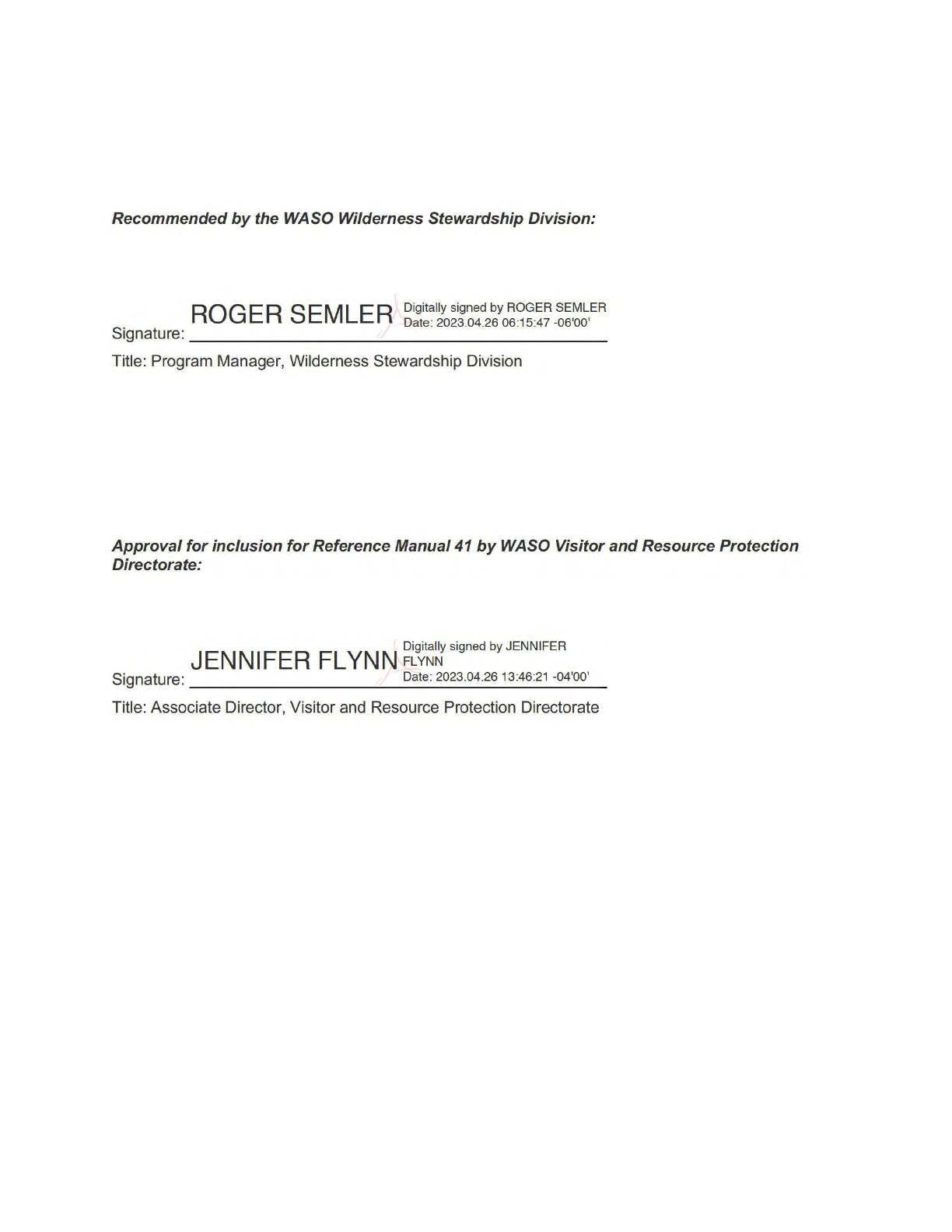
National Park Service Reference Manual 41: NPS Wilderness Character Monitoring Technical Guide (version 1.0)
REFERENCE MANUAL 41: WILDERNESS STEWARDSHIP
NPS Wilderness Character Monitoring Technical Guide
Table of Contents
Re
commendation and Approval ……………………………………………………………….…… 2
Ac
knowledgments ………………………………………………………………………………….…. 3
In
troduction ……………...…………………………………………………………………….………. 5
Founda
tional Information ………………………………………………………………………….… 6
Wilderness Character Monitoring in the National Wilderness Preservation System …… 7
Wilderness Character Monitoring in the National Park Service (NPS) …………….......... 9
The Wilderness Character Monitoring Process ……………….…………………..…….... 14
Wi
lderness Character Monitoring by Quality
Untrammeled Quality …………………………………………………………………….…... 27
Natural Quality ……………………………………………………………………………..…. 29
Undeveloped Quality ………………………………………………………………….….….. 33
Solitude or Primitive and Unconfined Quality ………………………………………..……. 36
Other Features of Value Quality ………………………………………………………..…... 42
Re
ferences ……………………………………………………………………………….…….…..…. 47
Ap
pendices
Appendix A: Law and NPS Policy Framework for Wilderness Character Monitoring … 48
Appendix B: NPS Modifications to Keeping It Wild 2 …………………………………….. 50
Appendix C: List of Supplemental Wilderness Character Monitoring Tools Linked in
This Guide …………………………………………………………………...… 54
Li
st of Tables and Figures
Table 1. Key interagency wilderness character monitoring concepts ……….…………... 8
Table 2. Wilderness character monitoring qualities, monitoring questions,
and indicators ……………………………………………………………………… 12
Table 3. Data adequacy rating table ………………………………………………...…….. 19
Table 4. NPS groups and their respective WCM roles …………………………………... 24

National Park Service Reference Manual 41: NPS Wilderness Character Monitoring Technical Guide (version 1.0)
Recommendation and Approval | Page 2
Recommendation and Approval for Inclusion in Reference Manual 41
Recommended
by
the WASO Wilderness Stewardship Division:
ROGER SEMLER
Digitally signed by
RO
GER SEMLER
Date: 2023.04.
26
06:15:47 -06'00'
Signature:
_____________________
_
Title: Program Manager, Wilderness Stewardship Division
Approval for inclusion for Reference Manual
41
by
WASO Visitor
and
Resource Protection
Directorate:
Di
gitally signed by JENNIFER
JENNIFER FLYNN FLYNN
Signature: Date: 2023.04.2
613
:46:21 -04'0
0'
Title: Associate Director, Visitor and Resource Protection Directorate

National Park Service Reference Manual 41: NPS Wilderness Character Monitoring Technical Guide (version 1.0)
Acknowledgements | Page 3
Acknowledgements
Ma
ny thanks to the following staff for their leadership in authoring this Guide:
Erin Drake, Communications and Outreach Specialist – WASO Wilderness Stewardship
Division
Nyssa Landres, Wilderness Coordinator – Wrangell-St. Elias National Park and Preserve
Kristin Pace, Wilderness Coordinator – Yukon-Charley Rivers and Gates of the Arctic National
Park and Preserve
Danguole Bockus, Ecologist – Black Canyon of the Gunnison National Park
Roger Semler, Program Manager – WASO Wilderness Stewardship Division
And thank you to the following subject matter experts who provided helpful insights:
Wendy Berhman, Planner – WASO Park Planning and Special Studies Program
Davyd Betchkal, Biologist – WASO Natural Sounds and Night Skies Division
Brad Blickhan, Wilderness Coordinator – Glacier National Park
Jim Cheatham, Park Air and Visual Resource Specialist – WASO Air Resources Division
Eddie Childers, Wildlife Biologist – Badlands National Park
Blair Davenport, Regional Staff Curator – Interior Regions 8/9/10/12
Tim Devine, Training and Development Specialist – WASO Wilderness Stewardship Division
Joe DeVivo, Deputy Division Lead – WASO Inventory and Monitoring Division
Susan Dolan, Park Cultural Landscapes Program Manager – WASO Cultural Resources
Partnerships and Science Directorate
Greg Eckert, Restoration Ecologist – WASO Biological
Resources Divis
ion
Heather Eggleston, Program Manager – WASO National Natural Landmarks Program
Kirstie Haertel, Archaeology and Museum Program Manager – Interior Regions 8/9/10/12
Terri Hogan, Invasive Plant Program Lead – WASO Biological Resources Division
Jason Kenworthy, Geologist – WASO Geological Resources Division
Mark Kinzer, Regional Wilderness Coordinator – Interior Region 2
Laura Kirn, Cultural Resources Team Lead – Channel Islands National Park
Al Kirschbaum, GIS and Remote Sensing Specialist – Great Lakes Inventory and Monitoring
Network
Adrienne Lindholm, Regional Wilderness Program Manager – Interior Region 11
Lori Makarick, Landscape Restoration and Adaptation Branch Manager – WASO Biological
Resources Division
Liz Matthews, Inventory and Monitoring Program Manager – National Capital Area
Jillian McKenna, Wilderness Data Steward – Glacier National Park

National Park Service Reference Manual 41: NPS Wilderness Character Monitoring Technical Guide (version 1.0)
Acknowledgements | Page 4
Mike Medrano, Resource Stewardship and Science Division Manager – Guadalupe Mountains
National Park
Jack Oelfke, Retired – North Cascades National Park
Ashley Pipkin, Biologist – WASO Natural Sounds and Night Skies Division
Rebecca Port, Geologist – WASO Geological Resources Division
Gregor Schuurman, Ecologist – WASO Climate Change Response Program
Ruth Scott, Wilderness Coordinator – Olympic National Park
Ksienya Taylor, Natural Resource Specialist – WASO Air Resources Division
Jay Theuer, Cultural Resource Program Manager – Joshua Tree National Park
Dave Trevino, Wildlife Biologist – WASO Biological Resources Division
Dean Tucker, Natural Resource Specialist – WASO Water Resources Division
Dan van der Elst, Wilderness District Ranger – Mount Rainier National Park
Rose Verbos, Planner – Denver Service Center Planning Division
PJ Walker, Wilderness Coordinator – Everglades National Park

National Park Service Reference Manual 41: NPS Wilderness Character Monitoring Technical Guide (version 1.0)
Introduction | Page 5
Introduction
Pur
pose of the National Park Service Wilderness Character Monitoring Technical Guide
The purpose of this Guide is to provide national guidance on how to monitor and assess trends
in wilderness character for National Park Service (NPS) wilderness areas. This Guide supports
the NPS policy requirement that every wilderness park “will conduct a wilderness character
assessment, which includes identifying what should be measured, establishing baseline data,
and conducting ongoing monitoring of trends… Once a baseline is established, tracking change
and reporting on the trend in wilderness character should generally occur every five years”
(Director’s Order 41, Section 6.2 Wilderness Character).
This Guide applies to all areas in the NPS that have a statutory mandate and/or policy
requirement to preserve the wilderness character. See the “Wilderness in the NPS” section to
learn about NPS categories of wilderness.
Primary users of this Guide include wilderness managers, interdisciplinary park program
managers, and other field-level park staff who implement wilderness character monitoring
(WCM). National and regional NPS programs and partners that support parks in monitoring
efforts are also addressed here.
How This Guide is Organized
This Guide has three main parts
1
:
1. Foundational information: This section describes overarching WCM information for the
interagency National Wilderness Preservation System, the primary purpose for WCM in
the NPS, the NPS national framework for developing baseline assessments, the scope
of NPS lands to which WCM applies, and NPS roles and responsibilities for
implementing WCM.
2. WCM by quality: This section describes important information about each tangible
quality of wilderness character and its related WCM framework components. Example
measures and measure idea templates are listed for each quality.
3. Appendices: The appendices provide relevant background and context for WCM to
supplement information in this Guide.
To emphasize content that readers may want to revisit, three icons are used throughout this
Guide:
List of steps or concepts for reference.
Availability of a document template for use.
Ideas or questions to consider before advancing.
1
Many of the links referenced in this Guide connect to documents that only DOI employees can view.

National Park Service Reference Manual 41: NPS Wilderness Character Monitoring Technical Guide (version 1.0)
Foundational Information | Page 6
Foundational Information
What is Wilderness Character Monitoring and Why Do It?
The statutory mandate of the Wilderness Act is to preserve wilderness character. This
affirmative legal obligation applies to all designated wilderness areas across the entire National
Wilderness Preservation System (NWPS), including all NPS wilderness areas. This is affirmed
by NPS Management Policies 2006, Chapter 6 which states that management of these areas
will “preserve their wilderness character, and… the purpose of wilderness in the national parks
includes preservation of wilderness character…”
To ensure that wilderness character is preserved, it must first be defined. The Wilderness Act
does not define wilderness character. As such, a federal interagency wilderness team
collaborated to define wilderness character based on references and language from the
Wilderness Act (Landres et al. 2015):
Wilderness character is a holistic concept based on the interaction of (1) biophysical
environments primarily free from modern human manipulation and impact, (2) personal
experiences in natural environments relatively free from the encumbrances and signs of modern
society, and (3) symbolic meanings of humility, restraint, and interdependence that inspire
human connection with nature. Taken together, these tangible and intangible values define
wilderness character and distinguish wilderness from all other lands.
Given the breadth of this holistic concept, WCM focuses on a specific subset of tangible
qualities of wilderness character that are derived from the Definition of Wilderness, Section 2(c)
of the Wilderness Act:
1. Natural Quality
2. Untrammeled Quality
3. Undeveloped Quality
4. Solitude or Primitive and Unconfined Recreation Quality
5. Other Features of Value Quality
Through the lens of the five tangible qualities, WCM equips managers with a framework to
consider and steward changes that meaningfully affect the condition and trend of wilderness
character. Parks can use WCM information to assess the effects of past management decisions
on wilderness character and to inform decisions about future actions. WCM is distinct from other
forms of monitoring because monitoring results must be translated into a conclusion of impact
on wilderness character. This translation requires sound professional judgment and thoughtful
insight by managers. Subjectivity is a known element of WCM, as impacts to wilderness
character are nuanced, complex, highly variable, and necessitate professional judgment in
translating observed changes into management implications for wilderness character.
Simultaneously, the WCM framework is designed to counterbalance aspects of this subjectivity
by making processes and analyses more transparent and consistent.
Monitoring by itself does not provide guidance for what to do if trends in wilderness character
are declining; instead, monitoring can signal the need for follow-up actions or decisions and can

National Park Service Reference Manual 41: NPS Wilderness Character Monitoring Technical Guide (version 1.0)
Foundational Information | Page 7
clarify the tradeoffs associated with actions or decisions. The results from WCM can also
highlight qualities or aspects of wilderness stewardship that are changing in condition and may
need to be addressed by park management. Monitoring informs and helps improve wilderness
stewardship by encouraging management accountability for the central mandate of the
Wilderness Act - to preserve the wilderness character of every wilderness area for present and
future generations.
WILDERNESS CHARACTER MONITORING IN THE NATIONAL WILDERNESS
PRESERVATION SYSTEM
Interagency and Agency-Specific Wilderness Character Monitoring Guidance
The NWPS includes wilderness areas managed by the NPS, Bureau of Land Management
(BLM), US Fish and Wildlife Service (USFWS), and US Forest Service (USFS). This Guide is
related to, and builds on, existing WCM guidance for the NWPS and the NPS.
Keeping It Wild 2: An Updated Interagency Strategy to Monitor Trends in Wilderness Character
Across the National Wilderness Preservation System (KIW2) (2015)
KIW2 is the interagency monitoring strategy and framework of qualities, monitoring questions,
and indicators used in WCM. KIW2 updated the interagency framework of WCM and replaced
the original interagency Keeping It Wild (2008). KIW2 was endorsed in 2016 by the Interagency
Wilderness Policy Council and subsequently approved for inclusion in NPS Reference Manual
41: Wilderness Stewardship. The WCM framework defined in KIW2 provides the organizational
structure of this Guide. However, the NPS has made some agency-specific modifications to this
framework for NPS wilderness areas.
See each quality’s chapter and Appendix B in this Guide for additional details on
modifications to guidance described in KIW2. These modifications reflect lessons learned
since KIW2's release in 2016 regarding what is most useful to parks for WCM purposes. In
cases where guidance differs between KIW2 and this Guide, NPS users should refer to this
Guide.
KIW2 includes extensive descriptions of important WCM concepts. For brevity, these concepts
are not reiterated in this Guide. Instead, they are incorporated by reference (Table 1). This
approach in no way diminishes the importance or relevance of these concepts; they are
foundational to understanding the conceptual framework of WCM.

National Park Service Reference Manual 41: NPS Wilderness Character Monitoring Technical Guide (version 1.0)
Foundational Information | Page 8
Table 1. Key interagency WCM concepts described in Keeping It Wild 2
Interagency WCM Concept Keeping It Wild 2 Location
Assessing trend Pages 17-19, 24-29
Shared management responsibility with another
agency (BLM, USFWS, USFS)
Page 23
Detailed description of the five tangible qualities
of wilderness character
Pages 33-60
Detailed description of hierarchical framework
This Guide does offer flexibility for some
components of the KIW2 ‘required’ WCM
framework.
Pages 4,17-18
What is a trammeling action? Pages 101-106
Keeping It Wild in the NPS: A User Guide to Integrate Wilderness Character into Park Planning,
Management, and Monitoring (2014)
Keeping It Wild in the NPS is agency-specific guidance on how to integrate wilderness character
into park management. This includes introducing integral WCM-related items like the wilderness
character building blocks (including a wilderness character narrative and baseline assessment).
Because Keeping it Wild in the NPS was developed a year prior to KIW2, it does not reflect the
updated and revised WCM framework from KIW2 (and relevant updates in this Guide), but its
guidance for integrating wilderness character into overall park planning, management, and
monitoring is still relevant.
Survey Protocol Framework for Wilderness Character Monitoring on National Wildlife Refuges
(2018)
Measuring Attributes of Wilderness Character: Bureau of Land Management Implementation
Guide (2020)
US Forest Service Wilderness Character Monitoring Technical Guide (2020)
These three documents are the functional equivalents of this Guide for the USFWS, BLM, and
USFS. Portions of this Guide are modified from these documents to promote interagency
consistency where feasible.

National Park Service Reference Manual 41: NPS Wilderness Character Monitoring Technical Guide (version 1.0)
Foundational Information | Page 9
WILDERNESS CHARACTER MONITORING IN THE NATIONAL PARK
SERVICE
Wilderness in the NPS
Over 44 million acres of NPS lands are designated as wilderness by Congress. An additional
26+ million acres of lands are eligible, proposed, recommended, and potential wilderness. In
total, over 80 percent of the entire National Park System is managed as wilderness.
The mandate to preserve wilderness character applies to all categories of wilderness per NPS
policy. NPS Management Policies 2006, Chapter 6 states “[f]or the purposes of applying these
policies, the term ‘wilderness’ will include the categories of eligible, study, proposed,
recommended and designated wilderness.” Accordingly, WCM will be conducted for all NPS
categories of wilderness.
NPS Primary Purpose of Wilderness Character Monitoring
NPS WCM aims to principally support park-specific wilderness character needs. The primary
purpose of WCM in the NPS is to help parks consider and steward changes that meaningfully
sustain or improve the condition and trend of the park’s wilderness character. This emphasis on
local relevance means that the strength of servicewide WCM functions (i.e., national condition
and trend assessments for wilderness character) may be diminished to achieve this place-
based purpose. This tradeoff is both recognized and accepted.
NPS Wilderness Character Monitoring Definitions
The following terms are essential to the NPS WCM process. These
definitions are NPS-specific and may differ from another agency’s
interpretation of the term.
• Baseline measure value = the reported value (quantitative or
qualitative) for a measure from the ‘baseline measure year’.
This value is the reference/comparison point to assess the
‘trend’ in a specific measure over time, where the current
‘reported measure value’ is compared to the baseline measure
value.
• Baseline measure year = the earliest year data is available to
report a ‘baseline measure value’ for an individual measure.
• Change = an informal comparison of the state of wilderness
character for a ‘measure,’ ‘indicator,’ ‘monitoring question,’
‘wilderness character quality,’ or overall wilderness character.
Change is determined by comparing the ‘reported measure
value’ to the ‘baseline measure value’ for measures with fewer
than five data points informing the current ‘reported measure
value.’ Like ‘trend’, interpreting change should be informed by
the measure’s corresponding ‘threshold for meaningful change’ to help interpret the
comparison. Recognizing a ‘change’ in condition prompts managers to consider the
cause and effects of the change while awaiting enough data points to make official
‘trend’ conclusions.
WCM Terminology
Baseline measure value
Baseline measure year
Change
Indicator
Measure
Measure components
Modern
Monitoring
Monitoring question
Park
Reported measure value
Threshold for meaningful change
Trend
Wilderness character baseline
assessment
Wilderness Character Building
Blocks Report

National Park Service Reference Manual 41: NPS Wilderness Character Monitoring Technical Guide (version 1.0)
Foundational Information | Page 10
• Indicator = distinct and important components under each ‘monitoring question’ within
the ‘WCM framework’. There is at least one standardized indicator for every ‘monitoring
question’. Each indicator selected will have at least one corresponding ‘measure.’
• Measure = specific elements under each ‘indicator’ within the ‘WCM framework’. Each
measure yields data that is collected to identify condition and assess ‘trend’ in the
‘indicator’. Measures are selected by the park.
• Measure components = Individual components of a ‘measure’ that provide the detailed
parameters to successfully implement and monitor the ‘measure.’ Each selected
‘measure’ must address and document all measure components in the ‘Wilderness
Character Building Blocks Report’. Measure components include measure title, context
and relevance, definitions, protocol, data sources, data adequacy, frequency, threshold
for meaningful change, and caveats and cautions.
• Modern = the time since the area was first managed to preserve wilderness character.
For most parks, this will be the year a wilderness eligibility assessment, or equivalent
documentation, was completed.
2
The use of modern helps managers determine the
scope of time to consider when assessing impacts to wilderness character and does not
negate the longstanding and ongoing relationships shared between people and lands
currently managed as wilderness.
• (Long-term) Monitoring = the recurring monitoring of measures according to protocol
described in a park’s ‘Wilderness Character Building Blocks Report’ (and subsequent
WCM framework modification protocol). Monitoring intervals will depend on measure-
specific protocol described in the report, occurring every five years at minimum.
• Monitoring question = questions that frame essential components of each tangible
‘wilderness character quality’ within the ‘WCM framework.’ Each standardized monitoring
question has multiple ‘indicators.’
• Park = local NPS unit responsible for managing a specific wilderness area.
• Reported measure value = the reported value for a measure that serves as a
comparison to the ‘baseline measure value’ to assess ‘trend’ in the measure. This value
is reported every five years and may be a composite of several years of data, depending
on the measure’s protocol.
• Threshold for meaningful change = a quantitative and/or qualitative set of parameters
that interpret change in the current ‘reported measure value’ compared to the ‘baseline
measure value’. This comparison distinguishes minor/reasonable change (within
identified thresholds) from meaningful change (exceeding the identified threshold, which
can be positive or negative). The outcome of this change is used to determine ‘trend’.
• Trend = a formal comparative assessment of the state of wilderness character for a
‘measure,’ ‘indicator,’ ‘monitoring question,’ ‘wilderness character quality’, or overall
wilderness character of the area. Trend is officially determined by comparing the current
2
This definition of modern considers the social, cultural, and ecological conditions that precipitated the
creation of the Wilderness Act. Concerns about the pace of industrialization (i.e., ‘expanding settlement
and growing mechanization’) inspired wilderness supporters to consider ways of protecting public lands
from these ‘modern’ impacts. The definition of ‘modern’ may be modified if agreement is reached by the
park’s interdisciplinary wilderness team, including representation from cultural resources and facilities. A
thoughtful rationale for a modified definition must be documented in the Wilderness Character Building
Blocks Report.

National Park Service Reference Manual 41: NPS Wilderness Character Monitoring Technical Guide (version 1.0)
Foundational Information | Page 11
‘reported measure value’ to the ‘baseline measure value’ if the current ‘reported
measure value’ includes a minimum of five data points. Trend references the measure’s
corresponding ‘threshold for meaningful change’ to help interpret the comparison and
conclude if the trend is improving, stable, or declining. Absent the availability of five data
points, ‘change’ (rather than trend) between current and baseline measure values can
still be discussed and documented.
• Wilderness character baseline assessment = the comprehensive representation of all
required ‘WCM framework’ components applicable to a specific park that establishes a
reference point for future ‘trend’ comparisons. This assessment is complete when all
selected measures have an identified ‘baseline measure year’ and ‘baseline measure
value’.
• Wilderness Character Building Blocks Report = a document that includes both the
wilderness basics and ‘wilderness character baseline assessment.’ For the wilderness
character baseline assessment building block, the report documents the comprehensive
‘WCM framework’, including all selected ‘measures’ and related protocols, and ‘baseline
measure values’ and ‘baseline measure years’. This report should note the ‘WCM
baseline year’ and serves as a reference for all ‘monitoring’.
• WCM baseline year = the first year that data are reported for all measures in a park’s
‘WCM framework’. At a minimum, this means that at least one measure is identified for
every required indicator and each of these measures has a ‘baseline measure value’.
• WCM framework = the combination of all monitoring components for wilderness
character, including ‘wilderness character qualities’, ‘monitoring questions’, ‘indicators’,
and ‘measures.’
• Wilderness character quality = the primary tangible attribute(s) of wilderness character
that links directly to the statutory language of the Wilderness Act. Commonly referred to
as “the qualities”, the same set of five qualities applies to all federal wilderness areas:
Natural, Untrammeled, Undeveloped, Solitude or Primitive and Unconfined Recreation,
and Other Features of Value. Within the ‘WCM framework,’ each quality has at least one
corresponding ‘monitoring question.’
National Framework for WCM
The national framework for WCM in the NPS is based on the following concepts:
• The NPS uses a modified version of the KIW2 framework of wilderness character
qualities, monitoring questions, and indicators to promote interagency consistency while
providing for park-specific flexibility (Table 2).
• Each selected indicator must have at least one corresponding measure. For the NPS,
not all indicators are required. The decision to omit an optional indicator(s) must be
paired with a thoughtful and documented rationale in the Wilderness Character Building
Blocks Report.
1. Optional indicator: ‘Actions not authorized by the federal land manager that
intentionally manipulate the biophysical environment’ (Untrammeled Quality)
2. Optional indicator: ‘Presence of inholdings’ (Undeveloped Quality)
3. Optional indicator: ‘Remoteness from sights and sounds of human activity
outside of wilderness’ (Solitude or Primitive and Unconfined Recreation Quality)

National Park Service Reference Manual 41: NPS Wilderness Character Monitoring Technical Guide (version 1.0)
Foundational Information | Page 12
4. At least two measures for the Natural Quality must be selected (addressing a
minimum of two of the four indicators for this quality).
5. At least one measure for the Other Features of Value Quality must be selected
(addressing a minimum of one of the two indicators for this quality).
• Each NPS wilderness area has the flexibility to choose measures for the selected
indicators following the requirements above. No specific measures are required. For any
measure selected, thorough documentation of all measure components is critical.
• In general, measures selected for WCM should be:
o Useful: Select locally relevant measures that show how conditions are changing
over time and that are directly useful to stewardship decisions.
o Simple: Select the fewest measures that will credibly track change in the
indicator.
o Sustainable: Select measures that can be consistently monitored over time -
WCM is a long-term commitment.
3
Table 2. Wilderness character qualities, monitoring questions, and indicators for the NPS
Quality Monitoring Question Indicator
Untrammeled
What are the trends in actions
that intentionally control or
manipulate “the earth and its
community of life” inside
wilderness?
Required:
Actions authorized by the federal land
manager that intentionally manipulate
the biophysical environment
Optional:
Actions not authorized by the federal
land manager that intentionally
manipulate the biophysical environment
Natural What are the trends in the
natural environment from
human-caused change?
Required - Select at least two of the
following:
Plants
Animals
Air and water
Ecological processes
Undeveloped What are the trends in non-
recreational physical
development?
Required:
Presence of non-recreational
structures, installations, and
developments
3
Sustainability is not a static concept. Future modifications to measures may be needed, but measures
should be selected after first considering the anticipated long-term implications of selecting the measure.
See the “Modifying the WCM Framework” section for more information.

National Park Service Reference Manual 41: NPS Wilderness Character Monitoring Technical Guide (version 1.0)
Foundational Information | Page 13
Optional:
Presence of inholdings
What are the trends in
mechanization?
Required:
Use of motor vehicles, motorized
equipment, or mechanical transport
Solitude or
Primitive and
Unconfined
Recreation
What are the trends in
outstanding opportunities for
solitude?
Required:
Remoteness from sights and sounds of
human activity inside wilderness
Optional:
Remoteness from sights and sounds of
human activity outside wilderness
What are the trends in
outstanding opportunities for
primitive and unconfined
recreation?
Required:
Facilities that decrease self-reliant
recreation
Required:
Management restrictions on visitor
behavior
Other Features
of Value
What are the trends in the
unique features that are tangible
and integral to wilderness
character?
Required - Select at least one of the
following:
Deterioration or Loss of Integral
Cultural Features
Deterioration or Loss of Other
Integral Site-Specific Features of
Value
NPS Example Measures and Measure Idea Templates
This Guide lists and describes at least one example measure for every
required and optional indicator in the NPS WCM framework. Additionally,
measure idea templates are offered for measures used by some parks.
Use of example measures and/or measure idea templates is not required.
Example measures give users of this Guide a sense of how a specific
park interpreted and implemented the intent of a specific indicator.
Considering example measures can prompt discussions that yield more meaningful measure
creation as parks proceed through the WCM process. Example measures are not required and
not intended for wide-spread use. If a park is inspired by an example measure, substantial place-
based modifications may be necessary, as measure components like thresholds for meaningful
change and frequency must reflect local context.
Measure Idea
Templates
Example Measures

National Park Service Reference Manual 41: NPS Wilderness Character Monitoring Technical Guide (version 1.0)
Foundational Information | Page 14
Measure idea templates provide a modifiable structure for parks interested in using one or more
commonly used measures. The templates were co-created by NPS subject matter experts and
will be updated as needed.
The example measures and measure idea templates do not preclude a park from using other
measures (from existing monitoring efforts or newly created for WCM-specific purposes) to
locally address wilderness character. Remember, the primary purpose of WCM is to serve park-
identified wilderness stewardship needs. This purpose means all measures need to be locally
relevant and aid parks in understanding the state of wilderness character via specific
components of this large and complex concept.
THE WILDERNESS CHARACTER MONITORING PROCESS
Completing a wilderness character baseline assessment
There are five steps that should be taken by all parks to complete a wilderness character
baseline assessment.
Step 1: Ensure the wilderness boundary is accurate and available in GIS
Each wilderness area must have current and accurate geospatial boundary data to successfully
implement WCM. This GIS boundary information is a foundation for conducting more accurate
analysis and monitoring. Review the NPS Wilderness GIS Boundary Creation/Verification
Guidance to learn more.
Step 2: Holistically consider the WCM framework through the lens of park-identified
wilderness stewardship priorities
The wilderness character baseline assessment and monitoring are only as useful as the
intentionality that goes into identifying WCM details. Before diving into measure selection details,
parks are encouraged to take a step back and holistically consider the WCM framework through
the lens of park-identified wilderness stewardship priorities. Holistic consideration includes
involving perspectives from different park disciplines and initiating discussions with ample time to
discuss, reflect, and refine.
With the WCM framework of qualities, monitoring questions, and indicators in hand,
discussions can begin. Questions to guide these discussions include:
Wilderness Character Baseline Assessment in Five Steps
1. Ensure the wilderness boundary is accurate and available in GIS.
2. Holistically consider the WCM framework through the lens of park-identified wilderness
stewardship priorities.
3. Select measures, including identification of all measure components.
4. Confirm availability of measure data.
5. Compile and document the wilderness character baseline assessment

National Park Service Reference Manual 41: NPS Wilderness Character Monitoring Technical Guide (version 1.0)
Foundational Information | Page 15
• Are there existing measures with available data that could provide important information
for the support of park wilderness stewardship, and thus should be considered in WCM
measure selection (e.g., desired conditions and thresholds associated with a Wilderness
Stewardship Plan)?
• What is considered the biggest threat(s) to wilderness character in terms of the X
indicator for the park?
• What are potential negative aspects of missing or ignoring changes in this threat(s)?
• Is there an aspect(s) of wilderness character that is especially well preserved/protected
right now? Why is this occurring? Is this something that needs to be monitored into the
future to ensure its continued preservation/protection?
• Is it worth using two or more different measures to holistically capture aspects of the X
indicator?
• Are there other aspects related to the X indicator that should also be considered?
• What data are or will be available to support each potential measure? Data includes
quantitative and qualitative sources.
• How should existing data and established protocol (versus creating something new that
is tailored to WCM) influence measure selection?
• What process will be used to develop and justify thresholds for meaningful change in
tandem with measure selection?
• How sensitive should the threshold for meaningful change be? Should it serve as a red
flag for coming change, or should it convey change that has clearly happened already?
• How might resulting trend conclusions (based on the measure and threshold for
meaningful change) potentially inform management or policy decisions?
Whether using these questions or others to think through the process of identifying WCM-
wilderness stewardship priorities, it is important that threats to wilderness character, as well as
current wilderness character preservation successes (that the park wants to continue or expand
on in the future), are identified prior to measure selection. This ensures time invested in WCM is
well-spent and yields helpful information for subsequent park planning, management, and
operations.
During this step, parks should also be aware of the individual measure components that inform
each measure. Notably, measures and thresholds for meaningful change should be
simultaneously identified. A threshold for meaningful change identifies what amount of change
in a measure qualifies as meaningful relative to wilderness character. Retroactively assigning a
threshold to an already selected measure may fail to identify change that meaningfully affects
wilderness character. Exploring measure options in tandem with thresholds for meaningful
change offers insight specific to park-identified wilderness stewardship priorities. For parks with
Wilderness Stewardship Plans, this includes considering how potential WCM thresholds for
meaningful change relate to plan components like thresholds and desired conditions. See the
“How WCM Relates to Wilderness Stewardship Planning, Compliance, and Operations” section
for more details.

National Park Service Reference Manual 41: NPS Wilderness Character Monitoring Technical Guide (version 1.0)
Foundational Information | Page 16
Step 3: Select measures, including identification of all applicable measure components
Once the WCM framework and park-specific wilderness stewardship priorities are holistically
considered, parks can select measures and identify details for all applicable measure
components. See the "Components Described for Each Measure” section for more information.
Remember, at least one measure must be identified for every required indicator, per the NPS
national WCM requirements.
Step 4: Confirm availability of measure data
If adequate data is available for all selected measures, proceed to Step 5.
In some cases, park-identified wilderness stewardship priorities may not
have relevant data immediately available for use in WCM. This is not a
dead end for engaging in the WCM process! Parks with WCM data gaps
should use the NPS Status Report for In-Progress WCM Baseline
Assessment Template to document their progress and help keep the
WCM process moving forward.
Step 5: Compile and document the wilderness character baseline assessment
The wilderness character baseline assessment is complete when there
is a baseline measure value for each selected measure (and there is at
least one measure for each required indicator). Once the wilderness
character baseline assessment is complete, a Wilderness Character
Building Blocks Report should be developed. This report documents a
park’s WCM framework, measures selected, measure components, and baseline measure
years and values. Some parks find it helpful to begin drafting the report in tandem with Step 2,
where all WCM framework details are documented in-real time rather than writing the report
afterwards. Parks are encouraged to use the Wilderness Character Building Blocks Report
Template
4
for the final report
5
.
When a draft Wilderness Character Building Blocks Report is complete, parks will submit the
draft to the NPS WASO Wilderness Stewardship Division for review
(wilderness_stewardship@nps.gov). Additional report reviewers are optional, including the NPS
Regional Wilderness Coordinator.
After the above reviews are complete, the park superintendent (or their designee) should
approve and sign the final Wilderness Character Building Blocks Report. This signature
validates the park’s wilderness character baseline assessment and indicates commitment to
4
The wilderness character building blocks include 1) the Wilderness Basics, 2) Wilderness Character
Baseline Assessment, and 3) Integrating Wilderness Character into Park Operations (not typically
documented in the Wilderness Character Building Blocks Report). Parks are encouraged to develop the
Wilderness Basics prior to initiating a baseline assessment. Learn more via the Wilderness Character
Building Blocks Resource Brief.
5
Optional publication of the Wilderness Character Building Blocks Report through the NPS Natural
Resource Report Series (NRR) is available.
NPS Status Report for
In-Progress WCM
Baseline Assessment
Template
Wilderness Character
Building Blocks
Report Template

National Park Service Reference Manual 41: NPS Wilderness Character Monitoring Technical Guide (version 1.0)
Foundational Information | Page 17
ongoing WCM. Once signed, parks should provide a digital copy (or link) of the final report to
the NPS WASO Wilderness Stewardship Division.
In addition to the Wilderness Character Building Blocks Report, parks will need to enter their
wilderness character baseline assessment data into the WCM national database.
Process for using the WCM national database:
1. Complete the wilderness character baseline assessment and corresponding Wilderness
Character Building Blocks Report.
2. Identify the park’s data steward for data entry.
3. Email the NPS WASO Wilderness Stewardship Division
(wilderness_stewardship@nps.gov) to set-up a database account.
4. Enter wilderness character baseline assessment data in database.
5. Enter measure values for each five-year monitoring interval into the database. Data that
informs five-year reporting data (i.e., annual measure values) for each measure should
be logged and maintained on a park-managed database (or other record) at the intervals
defined in the protocol, as data can only be entered at five-year intervals in the national
database.
Components Described for Each Measure
Every measure used in WCM must describe the following components.
It is important to ensure appropriate documentation is provided for
each section.
Measure title. This is the title of the measure. Titles should be succinct
while providing enough detail to convey the purpose of the measure.
Context and relevance. This section explains why the measure is
relevant and gives background information that helps inform the reader
of context that ultimately led to the measure’s selection.
Definitions. This section defines terms relevant to understanding and
monitoring the measure. When used in a WCM context, some terms
have specific meanings which may not correspond to how managers otherwise use these terms
(such as “trammeling,” “installation”, and “development”).
Protocol. This section provides step-by-step instructions on how to implement and analyze the
measure, outlining the steps needed to arrive at a final reported measure value.
6
Protocol
should provide clear, repeatable instructions for monitoring. Modifications to protocol (that may
6
Protocol should reflect park-specific distinctions that make the measure both useful and feasible. For
example, parks may use a representative sample instead of a comprehensive inventory for count-based
measures. Other measures may outline a multistage approach, where one measure is used until
presence as a threshold is passed (e.g., presence of XX detected where previously XX did not exist),
followed by a shift to a measure accounting for potential and observed impacts after presence has been
confirmed.
Measure Components
Measure title
Context and relevance
Definitions
Protocol
Data sources
Data adequacy
Frequency
Threshold for meaningful change
Caveats and cautions

National Park Service Reference Manual 41: NPS Wilderness Character Monitoring Technical Guide (version 1.0)
Foundational Information | Page 18
emerge over time) should also be documented here, noting the full sequence of original to
modified protocol, so as to give the reader context for potentially observed discrepancies. See
the ‘Modifying the WCM Framework’ section of this Guide for more details.
Data sources. This section identifies the source(s) and location(s) of the data used for WCM.
Data can include qualitative, quantitative, and mixed methodology sources. To be clear, well
documented professional judgment and other qualitatively described subject matter expertise is
an appropriate data source for WCM. For all data sources, details for locating data should be
documented, including links to online data sources, pathways for digital documents located on
network drives, and descriptions of where to find hard-copy files.
Data adequacy. This section addresses the reliability of the data to assess trends in the
measure. It encompasses both data quality and data quantity. Data adequacy is an assessment
of the reliability and confidence in the data used for each measure -- determined by assessing
data quantity and quality. Each measure describes both data quantity and quality, using the
assessment metrics below, and concludes with an overall data adequacy “rating.”
Data quantity refers to the level of confidence that all necessary and appropriate data records
have been gathered. In determining the best available information for a park, “available” refers
to information that currently exists in a useful form, and that does not require further collection,
modification, or validation. If the available data are insufficient in quantity, they may still be
considered the best available information for the park. Data quantity is described by the
following three categories, determined by the park:
1. Complete—This category indicates a high degree of confidence that all necessary and
appropriate data records have been gathered.
2. Partial—This category indicates a medium degree of confidence that all necessary and
appropriate data records have been gathered. Some data are available but are generally
considered incomplete.
3. Insufficient—This category indicates a low degree of confidence that all necessary and
appropriate records have been gathered. Few or no data records are available.
Data quality refers to the level of confidence about the data source and whether the data are of
sufficient quality to reliably identify trends in the measure. Data quality is assessed by the data’s
accuracy (the degree to which the data express the true condition of the measure and not other
sources of variation affecting the measure), reliability (the degree to which the data follow
established or well-developed protocols), and relevance (the degree to which the data are
spatially and temporally appropriate for the measure). In general, the highest quality data will be
considered the best available information. Remember, WCM data can be quantitative,
qualitative, or mixed methodology. Data quality is described by the following three categories,
determined by the park:
1. Good—This category indicates a high degree of confidence that the quality of the data
can reliably assess trends in the measure. Data are highly accurate, reliable, and
relevant for the measure.
2. Moderate—This category indicates a medium degree of confidence about the quality of
the data. Data are only moderately accurate, reliable, or relevant.

National Park Service Reference Manual 41: NPS Wilderness Character Monitoring Technical Guide (version 1.0)
Foundational Information | Page 19
3. Poor—This category indicates a low degree of confidence about the quality of the data.
The accuracy, reliability, or relevancy of the data is minimal or unknown.
Parks must evaluate data quantity and quality for all potential data sources. An overall
determination of data adequacy is derived by combining the assessments of quality and quantity
(Table 3) and is categorized as high, medium, or low. Numerical values are included as an
optional level of detail to document the data adequacy ‘rating’.
Table 3. Data Adequacy Rating Table
Data Quantity + Data Quality = Data Adequacy
Complete (3)
+
Good (3)
=
High (6)
Partial (2) Moderate (2) Medium (4-5)
Insufficient (1) Poor (1) Low (<3)
There is no minimum data adequacy rating required to use a particular data source. Instead,
determining data adequacy ensures the park is aware of the tradeoffs of using the identified
data source (tradeoffs that should be well documented in the Wilderness Character Building
Blocks Report). Similarly, the data adequacy of a seemingly similar data source may vary from
park to park. For example, data relying on professional judgment may receive a medium or high
data adequacy rating at park A due to the degree of detail documented over a long timeframe,
whereas park B considers data from professional judgment to be a low data adequacy rating
because little is documented, and the primary source is unavailable to interview further.
While data adequacy is not used to determine a measure’s trend, it is crucial for interpreting
trends (e.g., if there is a declining trend but data adequacy is low, then confidence in this trend
would also be low) and for revealing when additional or different data collection efforts may be
needed.
Frequency. This section identifies how often measures should be monitored to determine a
reported measure value. In some cases, measures will only be monitored once every five years,
in accordance with the WCM minimum monitoring frequency requirement. In other instances,
the reported measure value for the five-year monitoring interval is a composite of multiple
measure values collected in between the current and previous monitoring interval.
Threshold for meaningful change. This section explores how change in a measure affects
wilderness character. This section helps distinguish WCM from other NPS monitoring efforts
because it links the measure’s intent and corresponding measure value to wilderness character
impacts.
As Step 2 of the “Completing a Wilderness Character Baseline Assessment” section
indicates, thresholds for meaningful change should be determined in tandem with selecting
the measure to ensure a park is measuring something that can affect wilderness character.
Arriving at this determination requires discussion, considering questions like:

National Park Service Reference Manual 41: NPS Wilderness Character Monitoring Technical Guide (version 1.0)
Foundational Information | Page 20
• What process will be used to develop and justify thresholds for meaningful change in
tandem with measure selection?
• How sensitive should the threshold for meaningful change be? Should it serve as a red
flag for coming change or should it convey change that has clearly happened already?
• How do potential thresholds for meaningful change relate to thresholds and desired
conditions identified in park planning documents, like a Wilderness Stewardship Plan?
• How do potential thresholds for meaningful change relate to the condition of wilderness
character?
The process of determining thresholds for meaningful change is subjective because it typically
depends on place-based professional judgment. There is no ‘objective’ process that can make
this decision for managers. The complexity, nuance, and context present in a wilderness area
must all be accounted for when determining thresholds for meaningful change. This subjectivity
means that thresholds for meaningful change will likely differ from park to park. Examples of
thresholds for meaningful change include, but are not limited to any change, additive change,
percent or multiplicative change, and in some instances, statistical reasoning (if assumptions
are assessed).
Caveats and cautions (if applicable). This section describes considerations or other relevant
context to keep in mind for the measure. Documentation may expand on known concerns with
the measure or make note of potential future modifications that should be revisited during the
next monitoring interval.
Key Principles of WCM
To successfully implement this monitoring, NPS staff need to understand the following
principles:
A park’s WCM framework is likely to change over time — Consistently using the same
measures and measure components over time to determine trends in wilderness character is
ideal - but parks should be prepared to evolve and make thoughtful changes if needed.
Changes may be prompted by new issues or policy direction, the emergence of new data
sources that better address local wilderness stewardship priorities, etc. See the “Modifying the
WCM Framework” section for more details.
Lands designated or managed as wilderness are living cultural landscapes. Thoughtful
consideration should be given to cultural practices and traditions while identifying wilderness
stewardship priorities that are related to WCM — Wilderness character is a combination of
many interrelated factors. These factors inform a park’s identified wilderness stewardship
priorities and the threats and successes for wilderness character preservation. Because
wilderness lands are a living cultural landscape, managers should be sensitive to how
wilderness stewardship priorities are determined and framed, demonstrating sensitivity for past
and ongoing cultural practices and traditions that may intersect with factors influencing
wilderness character.

National Park Service Reference Manual 41: NPS Wilderness Character Monitoring Technical Guide (version 1.0)
Foundational Information | Page 21
Management actions often impact more than one quality of wilderness character. For practical
reasons, not all qualities impacted may be monitored — Generally speaking, actions that affect
more than one quality of wilderness character will be measured only for the quality that is most
directly impacted. This helps prevent redundancy in the influence of that action on trend
determinations. However, if a park feels strongly that an action should be evaluated through the
lens of multiple qualities, and appropriate measures are selected, this is also acceptable. In this
instance, an explanation for its inclusion (and recognition of potential redundancy) needs to be
documented in the ‘Caveats and cautions’ component of the measure.
Management decisions may preserve or degrade these qualities, and cumulative impacts matter
– Wilderness character may be improved, preserved, or degraded by the actions managers
decide to take or not take. Protecting one quality of wilderness character may diminish another.
Over time, tradeoffs affecting different qualities of wilderness character and the cumulative
results of seemingly small decisions and actions may cause a significant gain or loss of
wilderness character. With an established WCM framework to discuss these tradeoffs within the
context of wilderness character and its five tangible qualities, managers have a tool (to use
alongside other tools) that helps to preserve wilderness character as a whole.
Measures that are integral to wilderness character may be monitored, regardless of managerial
jurisdiction — Resources that are integral to the area’s wilderness character, but that are not
directly under the jurisdiction of managers, are included in this monitoring to the extent that is
practical.
Selective use of site-specific measures is permitted — While WCM focuses on monitoring
trends in wilderness character across an entire wilderness area, it is not always practical to
exclusively select measures that can be monitored area-wide. For instances where a site-
specific measure (i.e., portion(s) of the wilderness area that does not encompass the entirety of
the wilderness area) enables a park to meaningfully measure something of high priority, a site-
specific measure is appropriate. The rationale for using a site-specific measure, and
acknowledgement of the tradeoffs for this decision, should be documented in the Wilderness
Character Building Blocks Report.
Long-term Wilderness Character Monitoring
WCM does not end with the wilderness character baseline assessment. Long-term monitoring is
the recurring monitoring of measures according to protocol described in a park’s Wilderness
Character Building Blocks Report (and subsequent WCM framework modification protocol).
Monitoring intervals will depend on measure-specific protocol described in the report. At a
minimum, this monitoring will occur every five years to identify current reported measure values.
The reported measure values will be compared to the baseline measure values to determine
trend.

National Park Service Reference Manual 41: NPS Wilderness Character Monitoring Technical Guide (version 1.0)
Foundational Information | Page 22
For the five-year reporting intervals, parks are encouraged to use the
WCM Five-Year Reporting Summary Template to document measure
values and changes or trend. The summary can be appended to the
Wilderness Character Building Blocks Report for co-reference. Parks
will also need to enter the current reported measure values into the
WCM national database.
Determining Trend in Wilderness Character
Assessing overall trend in wilderness character provides a readily interpretable conclusion that
can help inform future management actions to better preserve wilderness character over time. A
trend of improving, stable, or declining is derived for each measure based on the comparison of
the reported measure to the baseline measure value and the corresponding threshold for
meaningful change
7
. This yields a trend determination at the measure level, which is then rolled-
up to determine trend at the indicator, monitoring question, and quality levels, culminating in a
trend for overall wilderness character of the wilderness area. Trend roll-ups are determined
using nationally consistent, interagency rules. These rules are described in KIW2’s “Assessing
Trend in Wilderness Character” section. The NPS distinction between official trend and change
differs from KIW2 guidance – while KIW2 rules for trend roll-ups still apply, parks should refer to
this Guide when deciding the point at which trend can be assessed in a measure
8
.
Modifying the WCM Framework
Change is inevitable and measure components, like data sources, protocol, thresholds for
meaningful change, and even overall measures are subject to change. When parks consider
making a modification to part of their WCM framework, focused discussions about tradeoffs to
proposed modifications should happen first, with interdisciplinary representation. Parks may
also contact their Regional Wilderness Coordinator and the WASO Wilderness Stewardship
Division to discuss the appropriateness and feasibility of proposed modifications.
Documenting modifications
When modifications are agreed-upon and finalized, documentation is a must. Parks should
update the Wilderness Character Building Blocks Report and/or WCM Five-Year Reporting
Summary with:
• The specific modification
• Date of the modification
• The reason(s) for this decision
• The potential impact(s) on interpreting trend in wilderness character
7
Trend is officially determined by comparing the current ‘reported measure value’ to the ‘baseline
measure value’ if the current ‘reported measure value’ includes a minimum of five data points. Trend is
determined by the measure’s corresponding ‘threshold for meaningful change’ to help interpret the
comparison and conclude if the trend is improving, stable, or declining. Absent the availability of five data
points, ‘change’ (rather than trend) between current and baseline measure values can still be discussed
and documented. Assessing changes in wilderness character prior to formal trend conclusions can yield
helpful information for managers that is further strengthened through trend assessments.
8
Within this Guide, references to ‘trend’ also represent ‘change’ where appropriate, based on the
limitations of how ‘change’ is defined.
WCM Five-Year
Reporting Summary
Template

National Park Service Reference Manual 41: NPS Wilderness Character Monitoring Technical Guide (version 1.0)
Foundational Information | Page 23
Modification impacts on determining trend
Depending on the specifics of the modification, this may substantially impact a trend
determination. Since trend is a comparison of the current reported measure value to the
baseline measure value (according to the threshold for meaningful change), a substantial
modification may mean the current measure is fundamentally different from the baseline
measure, making a comparison difficult. In cases where substantial discrepancies occur, parks
have two options:
1) Acknowledge the discrepancy in the five-year monitoring interval
Document the discrepancy and skip the trend determination for that particular measure during
the five-year monitoring interval the change occurred. If there is only one measure for the
required indicator, this also means there will be no trend for the indicator.
• Example: Park X’s baseline assessment included one measure about natural landcover
for the ‘Ecological Processes’ indicator (no other measures were used for this indicator).
Five years later, when the park was assessing trend between the baseline and first
monitoring interval, staff determined the natural landcover measure did not sufficiently
address the park’s wilderness stewardship priorities. Instead, the park wanted to use a
fire-related measure that they would begin collecting data on that year (establishing a
baseline measure value). Meanwhile, all other measures had not only a baseline
measure value, but a second reported measure value generated during the first
monitoring interval. The park decided to retain the original overall WCM baseline year
and assess trend for all other measures during this monitoring interval. This allowed the
park to also roll-up trend at all other levels of the WCM framework, recognizing that the
Ecological Processes indicator did not influence trend roll-ups because there was no
trend to report on. The next monitoring interval will resume inclusion of all measures
used as there will be a new reported measure value for the fire measure. This will allow
for the second trend assessment to include the Ecological Processes indicator too.
• Parks should be clear that this choice means an overall trend determination for
wilderness character is less holistic than prior or future monitoring intervals because
some aspects of wilderness character represented by the measure and/or indicator are
absent. Documentation of the rationale for this tradeoff is essential.
2) Revise the wilderness character baseline assessment
Update the wilderness character baseline assessment with the identified modification(s).
Depending on the details of the modification(s), this may result in changes to the measure
baseline year and the WCM baseline year too.
• Example: Using the same example as above, Park X’s baseline assessment included
one measure about natural landcover for the ‘Ecological Processes’ indicator (no other
measures were used for this indicator). Five years later, when the park was assessing
trend between the baseline and first monitoring interval, staff determined the natural
landcover measure did not sufficiently address the park’s wilderness stewardship
priorities. Instead, the park wanted to use a fire-related measure that they would begin
collecting data on that year. The park felt strongly that this new measure should
influence how trend is assessed for the park and thus opted to reset the overall WCM
baseline year to accommodate inclusion of this new measure. The park will postpone

National Park Service Reference Manual 41: NPS Wilderness Character Monitoring Technical Guide (version 1.0)
Foundational Information | Page 24
assessing trend until the second monitoring interval when every measure has a current
reported measure value to compare against the baseline measure value.
• Parks should be clear that this choice maintains best practices for determining trend,
supporting the holistic consideration of wilderness character. However, this approach
can set back the overall monitoring timeline, affecting the time before trend can be
determined. In other instances, these changes may not affect the trend timeline (e.g., a
new data set used has the same length of availability as the previously used data set; a
new approach to identifying thresholds for the measure does not affect when measure
values can be reported; etc.).
How This Guidance Relates to Parks That Have Already Implemented WCM
Parks that have already implemented WCM prior to the release of this Guide will need to
confirm that their monitoring protocol follows the NPS modified WCM framework described in
the “National WCM Framework” section. For WCM framework components that need updating,
the same two options apply as described in the “Modifying the WCM Framework” section. These
options apply not only to single measure changes, but other parts of the WCM framework
including the omission of now-optional indicators and now-required use of the Other Features of
Value Quality.
Roles and Responsibilities
Implementing WCM at a park is a collaborative effort between park staff, the region, the WASO
Wilderness Stewardship Division, and technical specialists. Table 4 describes the different
groups involved in WCM and their respective roles.
Table 4. NPS groups and their respective WCM roles
NPS Group WCM Role(s)
Park wilderness
coordinator
• Coordinate the development of the wilderness character
baseline assessment, documented in the Wilderness Character
Building Blocks Report.
Park interdisciplinary
staff
• Develop wilderness character baseline assessment, and
document in the Wilderness Character Building Blocks Report.
• Monitor wilderness character on a five-year interval minimum,
documented through the WCM Five-Year Reporting Summary.
• Enter wilderness character baseline assessment and
monitoring data into the WCM national database every five
years.
Park superintendent
• Review, approve, and sign Wilderness Character Building
Blocks Report.

National Park Service Reference Manual 41: NPS Wilderness Character Monitoring Technical Guide (version 1.0)
Foundational Information | Page 25
Regional Wilderness
Coordinators
• Support parks in developing wilderness character baseline
assessments and monitoring, including assistance with
identifying regional datasets, expertise, and potential
supplemental funding sources.
• Review and sign (for concurrence) Wilderness Character
Building Blocks Reports as needed (prior to Superintendent’s
signature).
• Liaise between the parks and WASO Wilderness Stewardship
Division for emergent WCM needs/issues.
WASO Wilderness
Stewardship Division
• Support park-based development of wilderness character
baseline assessments and monitoring, including assistance
with identifying national datasets, expertise, and potential
supplemental funding sources.
• Review and sign (for concurrence) Wilderness Character
Building Blocks Report (prior to Superintendent’s signature).
• Manage access to the WCM national database.
• Generate servicewide wilderness character trend reports as
appropriate.
• Update WCM policy and guidance as needed.
Other NPS Washington
Support Offices
(WASO)
• Support WCM through data collection, data access, or subject
matter expertise.
Interagency WCM Work
Group
• Coordinate WCM efforts between agencies.
Updating this Guide
The NPS Wilderness Character Monitoring Technical Guide will be updated and reviewed
periodically, coordinated by the NPS Wilderness Stewardship Division. These changes will be
catalogued, allowing users to access the most current version.
How WCM Relates to Wilderness Stewardship Planning, Compliance, and Operations
WCM should directly inform a Wilderness Stewardship Plan (WSP) (or equivalent plan), but it is
not a WSP itself. Ideally, parks would complete a WCM baseline assessment, documented in
the Wilderness Character Building Blocks Report, early in the WSP planning process (if this
assessment has not already been completed).
The WCM framework helps clarify park-specific wilderness stewardship priorities and results of
the WCM baseline assessment are the reference point for future wilderness character trend
determinations. These priorities and trend details can help inform desired conditions, standards,
management actions, and other planning components within WSPs (see Figure 1: WSP
Framework in the NPS Wilderness Stewardship Plan Handbook).

National Park Service Reference Manual 41: NPS Wilderness Character Monitoring Technical Guide (version 1.0)
Foundational Information | Page 26
WCM is not a singular decision or management plan. WCM should help inform planning efforts
involving wilderness - any decisions informed by WCM results are subject to other federal laws
(Americans with Disabilities Act, Clean Air Act, Clean Water Act, Endangered Species Act,
National Environmental Policy Act, National Historic Preservation Act, etc.) and NPS policy
requirements.
WCM should also be used as a means of informing priorities and needs for ongoing wilderness
stewardship operations.
The procedures outlined in this Guide meet the following compliance criteria established in the
NPS NEPA Handbook, Section 3.2 – Categorical exclusions for which no documentation is
required: “Plans, including priorities, justifications, and strategies, for non-manipulative research,
monitoring, inventorying, and information gathering.” The authority for categorically excluding an
action rests with the park unit’s superintendent (Director’s Order 12, Section 5.4).

National Park Service Reference Manual 41: NPS Wilderness Character Monitoring Technical Guide (version 1.0)
Untrammeled Quality | Page 27
Untrammeled Quality
The objective of monitoring the Untrammeled Quality is to assess
whether management of a wilderness area is trending over time toward
more or less intentional human manipulation of the biophysical
environment and community of life. Section 2(c) of the Wilderness Act
defines wilderness as “an area where the earth and its community of
life are untrammeled by man,” that “generally appears to have been affected primarily by the
forces of nature” and is an area “retaining its primeval character and influence.”
The Untrammeled and Natural Qualities are closely related, though they differ in a key way—the
Untrammeled Quality examines actions that intentionally control or manipulate ecological
systems inside wilderness, whereas the Natural Quality examines the effects on these systems
from actions taken inside wilderness or from external forces, regardless of management
objective. Separating actions from effects offers a clearer distinction between these two qualities
and their influence on overall wilderness character.
The Untrammeled Quality is explored through one monitoring question, one required indicator,
and one optional indicator.
MONITORING QUESTION: What are the trends in actions that intentionally control or
manipulate “the earth and its community of life” inside wilderness?
This single monitoring question for the Untrammeled Quality examines actions that intentionally
control or manipulate the components or processes of ecological systems inside wilderness. In
this context, intentional manipulation means an action that deliberately alters, hinders, restricts,
controls, or manipulates “the earth and its community of life.” This includes actions that affect
plants or animal species, insects and disease pathogens, physical resources (e.g., water or
soil), or biophysical processes (e.g., fire) inside a wilderness area.
When monitoring the Untrammeled Quality, all trammeling actions are counted the same
regardless of the area, intensity, frequency, or duration of their effects. This is because the
Untrammeled Quality focuses on whether a particular decision to manipulate “the earth and its
community of life” is made, not on the magnitude of that decision. In other words, taking any
trammeling action degrades the Untrammeled Quality, regardless of its scope and scale. For
practical reasons, however, this Guide considers magnitude when questions arise as to whether
a seemingly inconsequential action truly manipulates “the earth and its community of life” and
should be addressed.
Actions that degrade the Untrammeled Quality are typically the result of administrative decisions
made by managers. However, intentional activities by other federal and state agencies, non-
governmental organizations, or the public may also affect this quality. For this reason, parks are
required to monitor authorized trammeling actions and can optionally monitor unauthorized
trammeling actions if these actions are of high interest to the park and sufficient data sources
exist to monitor.
Essentially unhindered and
free from the intentional
actions of modern human
control or manipulation.

National Park Service Reference Manual 41: NPS Wilderness Character Monitoring Technical Guide (version 1.0)
Untrammeled Quality | Page 28
REQUIRED INDICATOR: Actions authorized by the federal land manager that
intentionally manipulate the biophysical environment
This indicator tracks all significant actions authorized by the park that intentionally manipulate
the biophysical environment, including those allowed under Section 4(d)(1) of the Wilderness
Act (which states “measures may be taken as may be necessary in the control of fire, insects
and disease, subject to such conditions as the Secretary deems desirable”). Intentional
manipulations taken by other federal agencies, state and tribal agencies, and private citizens
are included under this indicator if these actions are authorized by the park that manages the
wilderness. Trend in this indicator tracks whether managers are practicing restraint to allow a
wilderness area to exist in its free and self-willed condition.
OPTIONAL INDICATOR: Actions not authorized by the federal land manager that
intentionally manipulate the biophysical environment
This optional indicator attempts to identify actions that have not been authorized by the park that
intentionally manipulate the biophysical environment. Given the challenge to confidently account
for unauthorized actions, this indicator is not required and can be skipped if accompanied by a
thoughtful documented justification in the Wilderness Character Building Blocks Report.
For parks where unauthorized trammeling actions are of high concern and data adequacy is
reasonable, use of this indicator is encouraged. Unauthorized intentional manipulations of
plants, animals, physical resources, or biophysical processes within wilderness have the
potential to affect all qualities of wilderness character. These actions are fundamentally different
from those authorized by the park: most authorized manipulations undergo a review process to
determine their impacts on the various resources within wilderness, but unauthorized
manipulations are often undertaken with little to no consideration for their effects on broader
ecological systems within wilderness and on the other qualities of wilderness character.
MEASURES
Measure examples and measure idea templates for the two indicators above are
available for review and optional use.

National Park Service Reference Manual 41: NPS Wilderness Character Monitoring Technical Guide (version 1.0)
Natural Quality | Page 29
Natural Quality
The objective of monitoring the Natural Quality is to assess the effects
of modern civilization on the integrity of wilderness ecosystems, with a
focus on plants, animals, air and water, and ecological processes. The
Wilderness Act defines wilderness as an area that “is protected and
managed so as to preserve its natural conditions” and that these areas
should be free from the effects of “an increasing population, accompanied by expanding
settlement and growing mechanization” (Sections 2(c) and 2(a), respectively). Human-caused
changes to wilderness ecological systems can be intentional or unintentional.
In contrast to the Untrammeled Quality which monitors actions that manipulate or control
ecological systems, the Natural Quality monitors the effects on wilderness ecosystems from
human actions. While this quality encompasses all the naturally occurring species, physical
resources, and ecological functions and processes in wilderness, practical limitations require
that a relatively small but important subset of this quality are monitored.
The Natural Quality is a complex and challenging concept to monitor. Change over time and
from one place to another is a fundamental aspect of ecological systems and is an essential
aspect of this quality. The emphasis on modern human-caused change can inadvertently lead to
a false separation between humans and the rest of the biological world. In attempting to monitor
this quality, managers should be careful to not oversimplify contributors and effects, which are
often interrelated and inseparable. Exploring the concept of ‘ecological integrity’ may help
managers more holistically consider the complexity of this quality.
Modern humans are the focal source of identified effects. This distinction is simultaneously
important and difficult to implement. For the purposes of WCM, modern is defined as the time
since the area was first managed to preserve wilderness character. For most parks, this will be
the year a wilderness eligibility assessment, or equivalent documentation, was completed.
9
For practicality purposes, the Natural Quality inherently relies on a reference state (i.e., the
baseline measure value) to determine trend in the measure for the five-year monitoring
intervals. The conditions for trend determination are admittedly not ideal for this quality, since
these references depend on a fixed state that does not reflect the dynamic, ever-changing
complexity of ecosystems. This shortcoming should be acknowledged when developing WCM
details for the Natural Quality.
The Natural Quality is explored through one monitoring question and four indicators, where use
of at least two indicators is required.
9
The use of modern helps managers determine the scope of time to consider when assessing impacts to
wilderness character and does not negate the longstanding and ongoing relationships shared between
people and lands currently managed as wilderness. The definition of ‘modern’ may be modified if
agreement is reached by the park’s interdisciplinary wilderness team, including representation from
cultural resources and facilities. A thoughtful rationale for the definition modifications must be
documented in the Wilderness Character Building Blocks Report.
Ecological systems which
are substantially free from
the effects of modern
civilization.

National Park Service Reference Manual 41: NPS Wilderness Character Monitoring Technical Guide (version 1.0)
Natural Quality | Page 30
MONITORING QUESTION: What are the trends in the natural environment from human-
caused change?
This single monitoring question assesses the trends in wilderness ecosystems that result from
human-caused threats occurring since the area was first managed to preserve wilderness
character. As stated earlier in this chapter, hardline distinctions between change contributors
can be problematic and thoughtful reflection on the shortcomings of these distinctions should be
documented in the Wilderness Character Building Blocks Report. With the shortcomings
identified, parks should work to identify effects that include human causes, recognizing that
other factors may compound the issue but will not be as directly addressed in the WCM
framework.
Four indicators represent a range of ecosystem components and functions in wilderness: (1)
plants, (2) animals, (3) air and water, and (4) ecological processes. Parks are required to use at
least two of the four indicators. This increased flexibility empowers parks to engage with this
quality in meaningful and locally relevant ways, recognizing the challenges described in the
Natural Quality introduction.
Practical and conceptual constraints mean that not everything important to wilderness
ecosystems can be included. Likewise, not all ecological data and knowledge currently collected
by scientists and other knowledge holders are relevant or necessary to include in WCM.
Ecological components not included in this quality can still be acknowledged through the
qualitative Wilderness Character Narrative (part of the ‘Wilderness Basics’ building block) to
better convey the holistic scale of ecosystem health and functionality.
The Natural Quality’s indicators should be cautiously approached. The deceptive simplicity
of the Natural Quality's indicators could prompt parks to monitor animals, plants, air, water,
or ecological processes in isolation. For WCM purposes, monitoring needs to demonstrate a
relationship between the specific measure and overall wilderness character. Before determining
which of the Natural Quality’s indicators to use, parks should:
1. Think holistically about the Natural Quality - refer back to the quality’s definition and the
definition of wilderness character overall.
2. Consider which of the indicators help managers better understand the nexus between
that indicator/measure and wilderness character.
a. Stated in another way, just because there is data related to animals in wilderness
does not necessarily mean the ‘Animals’ indicator should be used - how does this
data (and the corresponding measure) meaningfully inform understanding of the
monitoring question, Natural Quality, and wilderness character as a whole?
3. Discuss: When an indicator is selected, how might the corresponding measure represent
more than one factor to avoid myopic focus that has a disproportionate influence on
trends in the Natural Quality?
a. For example, if a species-oriented measure is identified for the ‘Animals’ or
‘Plants’ indicators, consider the use of multiple species (either through multiple
measures or a single indexed measure) to better represent natural variation that
is also a part of wilderness character.

National Park Service Reference Manual 41: NPS Wilderness Character Monitoring Technical Guide (version 1.0)
Natural Quality | Page 31
IF SELECTED INDICATOR IS: Plants
This indicator focuses on threats to native plant species and communities. Native plant species
are an essential biological component of wilderness ecosystems, as they are uniquely adapted
to their local environment and contribute to ecosystem function via their interactions with other
organisms and the abiotic environment. Native plants play an important role by providing food
and habitat to animals, preventing soil erosion and contributing to soil health, and maintaining
healthy environmental conditions and biodiversity. Alterations of plant communities within
wilderness may result in changes to the composition, structure, and function of these
communities, as well as cascading effects to the larger community of life within the wilderness.
One of the primary threats to native plant communities is the introduction of invasive species (as
defined in Executive Orders 13112 and 13751) and the subsequent impacts of these invaders
on the ecological community. Three key terms are defined here for consistent reference (and
also apply to ‘Animals’ indicator):
• Invasive species = with regard to a particular ecosystem, a nonnative organism whose
introduction causes or is likely to cause economic or environmental harm, or harm to
human, animal, or plant health (see Executive Orders 13112 and 13751).
• Native species = with respect to a particular ecosystem, a species that, other than as a
result of an introduction, historically occurred or currently occurs in that ecosystem (see
Executive Orders 13112 and 13751).
• Nonnative species = with respect to a particular ecosystem, an organism, including its
seeds, eggs, spores, or other biological material capable of propagating that species,
that occurs outside of its natural range (see Executive Orders 13112 and 13751).
IF SELECTED INDICATOR IS: Animals
This indicator focuses on threats to native animal species and communities. Native animal
species and communities are an essential biological component of natural wilderness
ecosystems. They are critically important to the entire ecosystem by providing food and habitat,
digesting plant material and thereby making nutrients available in the soil for organisms to use,
scavenging carcasses of dead animals, and contributing to a wilderness ecosystem in many
other ways. If applicable, see definitions of ‘invasive species’, ‘native species’, and ‘nonnative’
species in “Plants” indicator for reference.
IF SELECTED INDICATOR IS: Air and water
This indicator focuses on threats to air quality and water quality and quantity. If this indicator is
selected, the park can monitor the air component, water component, or both components of the
indicator. Parks are not required to monitor both air and water to address this indicator.
Air and water are fundamental physical resources of wilderness ecosystems, and both are
essential to maintain properly functioning ecological systems inside wilderness. Both air and
water resources are vulnerable to degradation by pollutants produced outside of wilderness due
to human development and industrial activity. The protection of both resource categories comes
under the legal direction of the NPS Organic Act and the federal Clean Air Act and Clean Water
Act.

National Park Service Reference Manual 41: NPS Wilderness Character Monitoring Technical Guide (version 1.0)
Natural Quality | Page 32
The presence of airborne pollutants in soil and water within wilderness can have direct adverse
effects on sensitive plant and animal species and can directly impact essential ecosystem
functions, such as nutrient cycling. Certain air pollutants also can reduce visibility. Engaging
with other federal agencies, states, tribes, industry, and the public is important for advancing
strategies for avoiding and/or reducing the effects of air pollution on park resources and values
in all wilderness areas.
In addition to air pollutants, water quality and water flows are vulnerable to the effects of
physical manipulations inside and outside of wilderness. For example, dams outside a
wilderness can markedly affect water quantity and quality, as well as stream morphology, inside
a wilderness. Most existing NPS wilderness areas include relatively undeveloped headwater
watersheds with few water quality impacts. More recent additions to the NWPS may include
areas that are impacted by upstream watershed activities, such as by agriculture, mining, and
land development.
External threats to this indicator (i.e., threats outside park boundaries) can be challenging to
monitor, particularly when threats are more dispersed. Despite its challenges, these threats are
still important to acknowledge as they have equally impactful outcomes for wilderness
character. Identifying related measures may also help prepare parks to better engage with these
issues through partner relationship-building, public education, and cross-boundary collaboration.
Most parks are encouraged to monitor air according to the measures listed in the ‘Measure Idea
Templates’ supplement to this Guide. Water measures are more difficult to standardize and
have greater range in data availability. These challenges may mean not all parks are practically
able to include water in the WCM framework. For parks that do not include air and/or water
measures, these elements should be addressed qualitatively in the Wilderness Character
Narrative.
IF SELECTED INDICATOR IS: Ecological processes
This indicator focuses on threats to ecological processes that affect biotic and abiotic
components of wilderness ecological systems. Ecological processes are the interactions among
the biotic and abiotic components of ecosystems and include disturbance events (e.g., fire,
windstorms, insect and pathogen outbreaks), predation, competition, decomposition,
symbioses, nutrient cycling, etc.
The integrity of ecological processes is crucial to maintaining the Natural Quality of wilderness
character, and yet ecological processes are complex and can be difficult to measure. For high
priority ecological processes not addressed in the WCM framework, parks should describe their
importance in the Wilderness Character Narrative.
MEASURES
Measure examples and measure idea templates for the four indicators above are
available for review and optional use.

National Park Service Reference Manual 41: NPS Wilderness Character Monitoring Technical Guide (version 1.0)
Undeveloped Quality | Page 33
Undeveloped Quality
The objective of monitoring the Undeveloped Quality is to assess
whether a wilderness is becoming more developed over time.
Development can include such things as increasing evidence of
physical infrastructure or a greater prevalence of mechanized uses,
such as helicopters and chainsaws. The opening sentence of the
Wilderness Act, Section 2(a) states that the NWPS was created “in
order to assure that an increasing population, accompanied by expanding settlement and
growing mechanization, does not occupy and modify all areas within the United States…”
Section 2(c) of the Wilderness Act defines wilderness as “an area of undeveloped Federal land
retaining its primeval character and influence, without permanent improvements or human
habitation.”
Monitoring the Undeveloped Quality assesses how physical developments and motorized and
mechanized use within wilderness are trending over time. Key indicators and measures monitor
developments, inholdings, and various types of motorized and mechanized use.
The Undeveloped Quality is explored through two monitoring questions, two required indicators,
and one optional indicator.
MONITORING QUESTION: What are the trends in non-recreational physical
development?
This monitoring question addresses the presence of physical development that most often
typifies evidence of human occupation and modification, including both non-recreational
physical developments and inholdings.
REQUIRED INDICATOR: Presence of non-recreational structures, installations, and
developments
This indicator focuses on the physical evidence of human occupation and modification, such as
roads, buildings, and dams. Developments related to recreational use (e.g., trails, toilets,
bridges) are excluded because they are addressed in the Solitude or Primitive and Unconfined
Recreation Quality.
Per guidance in KIW2, developments are addressed in either the Undeveloped Quality or the
Solitude or Primitive and Unconfined Recreation Quality depending on their primary purpose.
Developments primarily installed for non-recreational administrative purposes should be
addressed in this quality, whereas developments that primarily serve a recreational purpose
belong in the Solitude or Primitive and Unconfined Recreation Quality, under the “Facilities that
decrease self-reliant recreation” indicator. For developments that may serve both administrative
and recreational purposes, it is up to the discretion of the park to decide which quality to assign
- parks should use their best judgment in this scenario and document their rationale in the
Wilderness Character Building Blocks Report. This split between administrative and recreational
developments helps prevent the double counting of related items. In this sense, the concept of
"substantially unnoticeable" can be applied to two wilderness character qualities.
Retaining its primeval
character and influence, and
essentially without
permanent improvement or
modern human occupation.

National Park Service Reference Manual 41: NPS Wilderness Character Monitoring Technical Guide (version 1.0)
Undeveloped Quality | Page 34
While this indicator tracks on the presence of administrative structures, installations, and
developments, it may be unrealistic to complete a comprehensive inventory for all parks. Parks
should approach this indicator in way that feels locally useful and practical, even if
comprehensive tracking is not feasible. This means that parks may decide to only focus on one
(or two) of the three components listed for this indicator (i.e., structures, installations,
developments) – if not all three components are addressed, a thoughtful rational should be
documented in the Wilderness Character Building Blocks Report. Parks should also decide if
unauthorized administrative developments should be included in this indicator. Tracking
unauthorized developments can be difficult and is not required.
For WCM purposes, parks should omit historical structures and other developed cultural assets
(i.e., installations) from this indicator (and the overall Undeveloped Quality) that pre-date the
year the area was first managed to preserve wilderness character. For most parks, this will be
the year a wilderness eligibility assessment, or equivalent documentation, was completed. This
means historical structures and other developed cultural assets that were built after the
wilderness eligibility assessment (or equivalent documentation) should be accounted for in this
indicator.
The positive contributions of cultural resources to wilderness character should be addressed in
the Other Features of Value Quality.
OPTIONAL INDICATOR: Presence of inholdings
This optional indicator focuses on the physical evidence of modern human occupation and
modification within inholdings.
10
Given that not all NPS wilderness areas have inholdings, and
the potential sensitivity of addressing private property in the WCM framework, this indicator is
not required and can be skipped if accompanied by a thoughtful documented justification in the
Wilderness Character Building Blocks Report.
For parks where inholdings are important to monitor because of their potential to substantially
affect wilderness character, use of this indicator is encouraged.
MEASURES
Measure examples and measure idea templates for the two indicators above are
available for review and optional use.
10
This indicator is optional for both parks with inholdings and those without inholdings.

National Park Service Reference Manual 41: NPS Wilderness Character Monitoring Technical Guide (version 1.0)
Undeveloped Quality | Page 35
MONITORING QUESTION: What are the trends in mechanization?
This monitoring question explores the effect of motorized equipment and mechanical transport
on the Undeveloped Quality. Ideally this would include authorized uses (such as for
administrative, emergency, and special provision purposes), as well as unauthorized uses.
However, including unauthorized uses is not required and should be decided by the park.
Although the Wilderness Act and subsequent legislation allow motorized equipment or
mechanical transport under certain conditions (see below for more information), their use
diminishes the Undeveloped Quality. Monitoring the use of motorized equipment and
mechanical transport over time can help make sound decisions informed by the Wilderness Act.
REQUIRED INDICATOR: Use of motor vehicles, motorized equipment, or mechanical
transport
This indicator focuses on the use of the three forms of mechanization discussed in Section 4(c)
of the Wilderness Act: (1) motor vehicles, (2) motorized equipment, and (3) mechanical
transport. These mechanization forms have direct and indirect impacts on the Undeveloped
Quality. Landing of aircraft should also be factored into measures associated with this indicator.
While this indicator tracks on the use of motor vehicles, motorized equipment, and mechanical
transport, it may be unrealistic to complete a comprehensive inventory for all parks. Parks
should approach this indicator in way that feels locally useful and practical, even if
comprehensive tracking is not feasible. This means that parks may decide to only focus on one
(or two) of the three components listed for this indicator (i.e., motor vehicles, motorized
equipment, mechanical transport) – if not all three components are addressed, a thoughtful
rational should be documented in the Wilderness Character Building Blocks Report.
MEASURES
Measure examples and measure idea templates for the indicator above are available for
review and optional use.

National Park Service Reference Manual 41: NPS Wilderness Character Monitoring Technical Guide (version 1.0)
Solitude or Primitive and Unconfined Recreation | Page 36
Solitude or Primitive and Unconfined Recreation Quality
The objective of monitoring the Solitude or Primitive and Unconfined
Recreation Quality is to assess whether management of a wilderness
is trending over time towards protecting outstanding opportunities for
the specific, unique recreational experiences cited in the Wilderness
Act. Monitoring focuses on three aspects of the quality:
1. Solitude
2. Primitive recreation
3. Unconfined recreation
The Solitude or Primitive and Unconfined Recreation Quality is explored through two monitoring
questions, three required indicators, and one optional indicator.
Meaningfully monitoring this quality
The Wilderness Act mandates federal land managers to protect outstanding opportunities for a
“solitude or a primitive and unconfined type of recreation” (Wilderness Act, Section 2(c)). These
recreational opportunities are subjective to the recreator and can make protecting them
particularly challenging. Also note the use of “outstanding opportunities for” - wilderness areas
are not expected to offer a sense of solitude or a primitive and unconfined recreational
experience all the time or in all wilderness settings. Rather, parks should consider whether the
wilderness area does have some opportunities to personally connect to these recreational
concepts. And while the NPS cannot guarantee that visitors will have such experiences, we
must protect conditions that promote such opportunities and keep them from declining over
time. Visitors may desire experiences other than those described in the Wilderness Act, but
those experiences are not part of the legislated requirement to preserve wilderness character.
Measures using qualitative or mixed methodology data sources - like surveys, interviews,
comment cards, etc. – are a preferred means to address the nexus between the wilderness
area and visitors’ perceptions of opportunities for solitude or primitive and unconfined
recreation. If a quantitative measure is practically necessary, an encounters-based measure is
encouraged. Parks should only use general visitation-based measures (e.g., annual wilderness
visitation, visitation trends, etc.) if one of the above options is prohibitively impractical to
implement.
During the early stages of discussing measure options for this quality, parks should
convene an interdisciplinary team to brainstorm ideas. Because the WCM framework splits
this quality into separate components for solitude versus primitive and unconfined, these
considerations can be asked about both halves of this quality. While similar questions can be
asked, each half of this quality is likely to generate different responses. Consider the following
questions to initiate discussion:
• What do opportunities for solitude/primitive and unconfined recreation mean to park
staff? Do you have any sense of how visitors feel?
Wilderness has outstanding
opportunities for solitude or
a primitive and unconfined
type of recreation.

National Park Service Reference Manual 41: NPS Wilderness Character Monitoring Technical Guide (version 1.0)
Solitude or Primitive and Unconfined Recreation | Page 37
o What does the scientific literature say about the meaning of solitude/primitive and
unconfined recreation?
• Does a solitude/primitive and unconfined experience feel (i.e., perceptions) different in
the wilderness area than elsewhere in the park?
• How does better understanding solitude/primitive and unconfined recreation in
wilderness relate to the park’s overall wilderness stewardship priorities?
• What does a meaningful way to measure opportunities for solitude/primitive and
unconfined recreation in wilderness look like for the park?
o
What tools/approaches could be used to measure this?
.
Surveys
. Post-trip interviews
. Comment cards (physical or digital)
. Other tools?
• If cost and time were not an issue, how would the park most like to measure
opportunities for solitude/primitive and unconfined recreation in the wilderness area?
o Is this option currently available to the park?
o If this option is not currently available, what are the limitations preventing the
park from pursuing it?
.
Are these limitations significant enough to remove this option from further
consideration?
If
after considering the above questions, the park is interested in exploring qualitative ways
to
understand opportunities for solitude/primitive and unconfined experiences, consider:
• How much capacity does the park have to collect and analyze qualitative data (duration,
frequency, method type)?
• What does solitude/primitive and unconfined recreation mean to a diverse range of
visitors or wilderness-interested people?
• Because this quality emphasizes opportunities for (rather than comprehensive
wilderness-wide offerings), are there particular locations, trip types, or dates/seasons
that the park is especially curious about?
• Are there existing OMB-approved generic packages that the park could use for this
effort?
Addressing offsetting impacts of this quality
The distinct components of this quality - solitude, primitive recreation, and unconfined recreation
– while equally important, can sometimes be at odds with each other. For example, actions
taken to enhance solitude (like requiring the use of permits) can simultaneously reduce
opportunities for unconfined recreation. This nuanced challenge demonstrates the tradeoffs
inherent to holistic wilderness character preservation and these tradeoffs should be thoughtfully
determined and well documented. See the ‘Management Restrictions on Visitor Behavior’
indicator for an example.

National Park Service Reference Manual 41: NPS Wilderness Character Monitoring Technical Guide (version 1.0)
Solitude or Primitive and Unconfined Recreation | Page 38
MONITORING QUESTION: What are the trends in outstanding opportunities for solitude?
This monitoring question addresses the experience of solitude. The Wilderness Act recognizes
that wilderness, protected from human development or settlement, can provide an opportunity
for solitude not available in other places. A review of wilderness writings suggests that solitude
encapsulates a range of experiences, including but not limited to privacy, being away from
civilization, inspiration, self-paced activities, and a sense of connection with times past (Borrie
and Roggenbuck 2001; Cole 2012; Lang 2018). Solitude is a multidimensional and deeply
personal value and experience. Parks should consider a holistic suite of potential solitude goals
their users may have, as preferences for what constitutes a solitude experience vary widely.
REQUIRED INDICATOR: Remoteness from sights and sounds of human activity inside
wilderness
The following broad indicator guidance should be consulted in coordination with place-based
conversations and research (if available) to ensure the park’s framing of solitude reflects local
context.
The opportunity to achieve solitude is often addressed as a function of both the density and
location of visitors within wilderness. The presence of other visitors outside one’s own group
may impact the solitude experience. Additionally, recreation impacts at campsites and other
locations where visitors congregate are some of the more prevalent and obvious human impacts
that wilderness visitors may encounter (Seekamp and Cole 2009).
Remoteness, meaning distance from the sights and sounds of civilization, may be important for
achieving a sense of solitude (Dawson 2004). Research shows that most wilderness visitors
stay on developed trails and most wilderness use concentrates within a few miles of trailheads
and access points, especially where day use makes up most of the visitation. Therefore, remote
locations further in on a trail or away from trails altogether, or recreation management practices
that limit use in popular areas within a wilderness (e.g., day or overnight use permits), may
provide opportunities for visitors to find solitude.
OPTIONAL INDICATOR: Remoteness from sights and sounds of human activity outside
wilderness
This optional indicator focuses on impacts to solitude that originate outside of the wilderness
boundary. Impacts from outside of wilderness can include both sights and sounds from the
surrounding park and those from outside the park entirely. Although legal protections of
wilderness do not extend to activities occurring outside a wilderness boundary, these activities
can still degrade the wilderness experience by affecting a sense of solitude. Given the
subjectivity of solitude and the challenges parks may face in addressing beyond-park threats to
this topic, this indicator is not required and can be skipped
11
if accompanied by a thoughtful
documented justification in the Wilderness Character Building Blocks Report.
11
Before omitting, parks are encouraged to consider the feasibility of this measure. If monitoring sights
and sounds entirely outside the jurisdiction of the park is not possible, are there other options available
(i.e., sights and sounds originating from outside the wilderness boundary, but still within the boundaries of
the park itself?)?

National Park Service Reference Manual 41: NPS Wilderness Character Monitoring Technical Guide (version 1.0)
Solitude or Primitive and Unconfined Recreation | Page 39
The following broad indicator guidance should be consulted in coordination with place-based
conversations and research (if available) to ensure the park’s framing of solitude reflects local
context.
Section 2(c) of the Wilderness Act defines wilderness as an area with “the imprint of [people’s]
work substantially unnoticeable.” As nearby population centers expand, the evidence of human
activities and developments outside and adjacent to wilderness increases, thereby decreasing
opportunities for solitude within wilderness.
Signs of human activity and development outside wilderness manifest in many ways, including
sounds from automobiles and off-highway vehicles on nearby travel routes, decreased visibility
from air and light pollution, and visual evidence of increasing urbanization from high ridges and
peaks. While many activities outside wilderness have the potential to affect the opportunities for
solitude within wilderness, not all activities will be monitored as data may be unavailable for
either the extent of the activities or their effect within wilderness.
MEASURES
Measure examples and measure idea templates for the two indicators above are
available for review and optional use.
MONITORING QUESTION: What are the trends in outstanding opportunities for primitive
and unconfined recreation?
This monitoring question helps emphasize the second half of the Solitude or Primitive and
Unconfined Recreation Quality. The primitive and unconfined elements of this quality help
translate Wilderness Act references to a more ‘undeveloped’ and ‘natural’ environment into a
recreational experience. Like the challenges of monitoring solitude, a sense of primitive and
unconfined recreation is subjective. And wilderness areas should protect opportunities for users
to experience their sense of what primitive and unconfined recreation means. For some, this
may mean non-motorized and non-mechanized travel, self-reliance, self-discovery, or the need
to palpably feel away from the pressures of a more fast paced, modern society.
Parks should consider a holistic suite of potential primitive and unconfined recreation goals their
users may have, as preferences for what constitutes this experience varies widely.
REQUIRED INDICATOR: Facilities that decrease self-reliant recreation
This indicator focuses on the presence of facilities in wilderness that decrease opportunities for
self-reliant recreation. Though many of these facilities are in place to protect resources and or a
sense of solitude, they may adversely affect opportunities for a primitive and unconfined
recreational experience. This dichotomy underlines the challenge of preserving wilderness
character and even preserving potentially conflicting aspects within the Solitude or Primitive and
Unconfined Recreation Quality. Tradeoffs are inherent to wilderness character preservation and
will be better understood through WCM. While a park’s WCM framework cannot account for and
balance every tradeoff, the Wilderness Character Building Blocks Report should document
tradeoffs and specifically acknowledge any shortcomings that cannot feasibly be addressed.

National Park Service Reference Manual 41: NPS Wilderness Character Monitoring Technical Guide (version 1.0)
Solitude or Primitive and Unconfined Recreation | Page 40
This indicator provides a means for measuring trends in the presence of durable or relatively
permanent facilities that reduce opportunities for primitive recreation. Recreation facilities can
include trails, bridges, signs, campsites, and other infrastructure. Although many recreational
facilities are physical developments that could be included under the Undeveloped Quality, to
avoid double counting, they are only counted under this quality and indicator.
REQUIRED INDICATOR: Management restrictions on visitor behavior
Management restrictions in wilderness are often adopted to protect resources or support
opportunities for solitude. However, unconfined recreation often refers to recreation types where
visitors experience a high degree of freedom over their own actions and decisions (Dustin and
McAvoy 2000; Dawson and Hendee 2009). Management restrictions are likely to degrade this
indicator.
This indicator addresses NPS restrictions on visitor behavior in wilderness, encompassing
formally adopted regulations or policies that govern visitor behavior, travel, or equipment.
Remember, this quality focuses on outstanding opportunities for solitude or primitive and
unconfined recreation. Wilderness areas are not expected to eliminate all management
restrictions. Instead, restrictions can vary and may be geographic, seasonal, or temporal in
scope, such as restrictions that occur year-round throughout the entire wilderness (or to a
particular location of the wilderness identified as especially integral to the area like the Black
Canyon in the Black Canyon of the Gunnison Wilderness or the Arrigetch Peaks in the Gates of
the Arctic Wilderness).
Off-Setting Effects within this Quality
Selecting appropriate measures for the Solitude or Primitive and Unconfined Recreation Quality
presents a complex and distinct challenge in that some management restrictions are
imposed with the intent of improving solitude, a structurally separate component of
this overall quality.
For example, group size limits are a management restriction commonly associated with
its negative effect on opportunities for primitive and unconfined recreation - yet the
same management restriction has a positive effect on improving solitude. For WCM purposes,
this scenario is considered an ‘offsetting’ effect on wilderness character.
12
Failure to adequately address offsetting effects and their conflicting relationship within the
same quality may result in a bias that is not entirely reflective of the overall trend for the
quality. Managers should consider one of the following options to reconcile this offsetting
conflict:
1. Include the restriction as part of the measure but describe the offsetting effects in
the Wilderness Character Building Blocks Report, Wilderness Character Narrative, and
12
Offsetting effects can occur within a single quality (e.g., solitude or primitive and unconfined recreation)
or between qualities (e.g., the Recreation Quality and the Natural Quality).

National Park Service Reference Manual 41: NPS Wilderness Character Monitoring Technical Guide (version 1.0)
Solitude or Primitive and Unconfined Recreation | Page 41
subsequent Five-Year Reporting Summaries to ensure the rationale is well documented
and helps inform how to interpret trends in this quality.
2. Eliminate potential bias within the same quality by excluding (and documenting)
offsetting restriction(s) from the measure.
3. Include the restriction in a weighted restriction index but assign it a weight of zero (or
reduce the weighting to be less than other restrictions).
4. Add at least one corresponding offsetting measure(s) in the ‘What are the trends in
outstanding opportunities for solitude’ monitoring question that represents benefits
afforded by management restrictions.
MEASURES
Measure examples and measure idea templates for the two indicators above are
available for review and optional use.

National Park Service Reference Manual 41: NPS Wilderness Character Monitoring Technical Guide (version 1.0)
Other Features of Value Quality | Page 42
Other Features of Value
Section 2(c) of the Wilderness Act defines wilderness as an area that
“… may also contain ecological, geological, or other features of
scientific, educational, scenic, or historical value.” Including such
features, if they exist and play an integral role in defining the meaning
and value of the area as wilderness, can provide a more holistic
picture of wilderness character. The objective of monitoring the Other
Features of Value Quality is to assess how the condition of important tangible features of
ecological, geological, scientific, educational, scenic, and historical value are changing.
Unlike the other qualities that apply to the entirety of a wilderness, the features monitored within
the Other Features of Value Quality usually occur only at specific sites, although some features,
such as cultural landscapes and certain geological or paleontological formations may occur over
larger areas. Additionally, for some features, there is no one site-specific feature that adequately
represents the feature of value, but rather a collection of individual site-specific features that
together are considered integral to wilderness character.
Threats to this quality result primarily from direct human actions (e.g., looting or vandalism) and
indirect human disturbances (e.g., camping or trail use) that create unintended adverse effects.
Although such damage is often associated with visitor use, other management activities (e.g.,
fire suppression activities or trail work) could also inadvertently contribute to disturbance.
Natural processes also contribute to deterioration in the condition of features over time if there is
no intervention.
The Other Features of Value Quality is explored through one monitoring question and two
indicators, where use of at least one indicator is required.
MONITORING QUESTION: What are the trends in the unique features that are tangible
and integral to wilderness character?
This monitoring question addresses the trend in the condition of tangible features that are
integral to wilderness character (e.g., those features that help define the meaning and
significance of the area). At this time, there is no standardized process or required criteria for
making determinations about integral features. Parks are responsible for making this
determination based on the specific context of both the wilderness area and the features within.
This monitoring question emphasizes the physical condition of identified features - the values
associated with the features are not directly addressed in the WCM framework. Values and
other intangible aspects of these features can be explored in the Wilderness Character
Narrative to ensure specific linkages between features, values, and wilderness character are
identified and documented.
Wilderness may also contain
ecological, geological, or
other features of scientific,
educational, scenic, or
historical value.

National Park Service Reference Manual 41: NPS Wilderness Character Monitoring Technical Guide (version 1.0)
Other Features of Value Quality | Page 43
While it is anticipated that measure trends in this quality may often be stable or declining,
projects to improve the condition of features (e.g., successfully removing graffiti from an integral
pictograph panel) could lead to an improving trend in this quality.
IF SELECTED INDICATOR IS: Deterioration or loss of integral cultural features
Cultural resources tell the human story of a place, representing the historical, cultural, social,
and spiritual values embedded in landscapes now managed as wilderness and may be tied to
the cultural identity of traditionally associated peoples. This indicator tracks the physical status
and condition of cultural resources (known here as ‘cultural features’) that are integral to the
wilderness character, including archeological resources, cultural landscapes, ethnographic
resources (including sacred sites and traditional cultural properties), and historic (and
precontact) structures.
To help determine which cultural features are integral to wilderness character, several
considerations should be examined first:
1. For structures and installations, refer to the “Identifying Cultural Resources that
Contribute to Wilderness Character” section in NPS Reference Manual 41’s Cultural
Resources in Wilderness: Guidance for Considering and Managing Historic Structures
and Installations.
a. See guidance regarding the two-step analysis, first determining what
"contributes" to wilderness character (i.e., what is integral?) and second
determining what is “necessary.”
2. For all other cultural feature types, consider:
a. Is the baseline information provided in the Cultural Resource Inventory System
accurate and reliable?
b. Is the feature listed on the National Register or recognized as a priority heritage
asset (for example, identified as significant in an agency plan)?
c. Does this site/feature/landscape represent a variety of cultural values? For
example, archeology site that is also part of documented cultural landscape and
is identified as an ethnographic resource.
Comprehensively monitoring all integral cultural features located within wilderness is
unachievable. In most cases, a representative sample of important, relevant, and specific
integral cultural features will be addressed in this indicator. This curated selection represents a
larger suite of integral cultural resources present in the wilderness area and does not diminish
or dismiss those resources not included in the representative sample. Parks should document
the rationale for their selection process in the Wilderness Character Building Blocks Report.
To identify a representative sample of integral cultural features, consider the variety of
available resources. Begin with primary resources created by the park’s Cultural Resource
Division:
• Cultural Resource Inventory System (CRIS) Records:
o Archeological Resources
o Cultural Landscapes
o Historic Structures

National Park Service Reference Manual 41: NPS Wilderness Character Monitoring Technical Guide (version 1.0)
Other Features of Value Quality | Page 44
o Ethnographic Resources
• National Register, World Heritage Site, and other nominations
• Historic Resource Study
• Archeological Overview, Assessment, or Research Design, Archeology Management
Plans
• Ethnographic Overview and Assessment, Ethnographic Resource Study, Traditional
Land Use Study
• Cultural Landscapes Inventory
• NPS Cultural Resource GIS Geodatabase and Park Resource Base Maps
Other park resources developed outside of the Cultural Resource Division will also be helpful.
Questions to further help guide the park in identifying integral cultural features include:
• Does the park have a Wilderness Stewardship Plan or other management direction that
may offer insight on how integral cultural features are determined?
• Does the park’s wilderness legislation (for designated wilderness areas) specifically
reference tangible cultural features? For parks managing ‘other categories of
wilderness’, does the Wilderness Eligibility Assessment or Wilderness Study address
integral cultural features?
• Do the park purpose, significance, and fundamental resources and values statements
(like in the park Foundation document) note important cultural themes and the tangible
features of cultural resources that represent them?
• Do the park’s cultural resource baseline documents identify tangible cultural features
that should have their relationship to wilderness character described?
• Is there scholarly or scientific place-based evidence to help evaluate whether specific
cultural features contribute to wilderness character in the park?
• Is there Traditional Ecological Knowledge (TEK) that supports the core values of both
traditional systems and the concept of wilderness? TEK is the system of experiential
knowledge gained by continual observation and transmitted among members of a
community.
In the absence of complete cultural resource baseline documents, parks should convene an
interdisciplinary team that includes the various cultural resource professionals to discuss ways
of addressing this indicator that recognizes data needs:
• If the park has a Cultural Resource Stewardship Assessment (CRSA), use the tables or
report to facilitate a discussion about cultural resources within the wilderness area. What
sites, features, or values are documented in the wilderness area? How do these
resources relate to wilderness character? What percentage of the wilderness has had
reconnaissance inventory done?
o If a CRSA has not been completed, the assessment and guidance for the
assessment may still be used to coalesce information and outline an approach
for cultural resource management in wilderness.
• Are there known cultural resources that are in highly dynamic landscapes or with other
known threats that require frequent monitoring as identified in CRIS or core treatment
documents?

National Park Service Reference Manual 41: NPS Wilderness Character Monitoring Technical Guide (version 1.0)
Other Features of Value Quality | Page 45
• Was wilderness designation pursued, in part, to help protect a specific cultural feature?
• Does the identified feature help bridge cultural values with complementary wilderness
character values (including biophysical, experiential, and symbolic meanings)?
• What wilderness character concepts connect to cultural resources or features?
• What are the park’s wilderness stewardship priorities that might relate to cultural
resources?
• Does the cultural feature represent the traditional homelands of historically or
traditionally associated groups, including both indigenous and non-indigenous people?
o Proactive and thoughtful collaboration with members of these groups is important
to ensure values are not misrepresented or based on assumptions.
• Have affiliated or associated groups identified features that require focused
stewardship?
IF SELECTED INDICATOR IS: Deterioration or loss of other integral site-specific features
of value
This indicator captures the condition of site-specific features, other than cultural resources,
determined to be integral to wilderness character. Intended to provide flexibility for parks to use
locally relevant context, this indicator addresses trends in certain natural or other features that
may be iconic to a specific wilderness area. Measures for this indicator can address ecological,
geological, scientific, educational, and scenic features.
For most parks, comprehensively monitoring all other site-specific features located within
wilderness is untenable - and, not all such features may be identified as integral to wilderness
character. In most cases, a representative sample of important, relevant, and specific features
will be addressed in this quality. This curated selection represents a larger suite of features
present in the wilderness area and does not diminish or dismiss their existence. Parks should
document the rationale for their selection process in the Wilderness Character Building Blocks
Report.
To help determine which non-cultural features are integral to wilderness character, review
existing documents and resources first. If unavailable, explore questions that can be posed
to an interdisciplinary team.
Existing documents and resources:
• Does the park have a Wilderness Stewardship Plan or other management direction that
may offer insight on how integral features are determined?
• Does the park’s wilderness legislation (for designated wilderness areas) specifically
reference tangible features? For parks managing ‘other categories of wilderness’, does
the Wilderness Eligibility Assessment or Wilderness Study address tangible features?
• Does the park purpose, significance, and fundamental resources and values statements
(like in the park Foundation document) note important features? Features referenced
here, that are also present in wilderness, should be further considered.

National Park Service Reference Manual 41: NPS Wilderness Character Monitoring Technical Guide (version 1.0)
Other Features of Value Quality | Page 46
• Does the park have special resource designations, like Biosphere Reserves, National
Natural Landmarks, National Trails, and Wild and Scenic Rivers? If part or all of such a
designation is located within wilderness, these areas should be further considered.
• Is there scholarly or scientific place-based evidence to help evaluate whether specific
features contribute to wilderness character in the park?
In the absence of formal documentation, parks should convene an interdisciplinary team to
brainstorm ideas:
• What is the first feature that comes to mind when the team thinks about the wilderness
area? What is it about this feature that strikes you? Does this relate to wilderness
character in some way?
• What does it mean to identify a feature that is integral to wilderness character for this
park? What are the park’s wilderness stewardship priorities that might relate non-cultural
aspects of the Other Features of Value Quality?
• Was wilderness designation pursued, in part, to help protect a specific feature?
o Does the description and significance of the feature share language similarities
with wilderness character concepts (including biophysical, experiential, and
symbolic meanings)?
o Are there conceivable sources of potential deterioration or loss that this feature
should be protected from (including loss of designation status, loss of physical
material, etc.)?
. If the feature has no real threats, it should be excluded from
consideration.
MEASURES
Measure examples and measure idea templates for the two indicators above are
available for review and optional use.

National Park Service Reference Manual 41: NPS Wilderness Character Monitoring Technical Guide (version 1.0)
References | Page 47
References
Borrie, W.T.; Roggenbuck, J.W. 2001. The dynamic, emergent, and multi-phasic nature of on-
site wilderness experiences. Journal of Leisure Research. 33(2): 202–228.
Bureau of Land Management (BLM). 2020. Measuring attributes of wilderness
character. BLM Implementation Guide Version 2.0.
https://wilderness.net/toolboxes/documents/WC/BLM%20Implementation%20Guide%20Version
%202.0.docx [Accessed October 13, 2022].
Cole, D.N. 2012. Wilderness visitor experiences: A selective review of 50 years of research.
Park Science. 28(3): 66–70.
Dawson, C. 2004. Monitoring outstanding opportunities for solitude. International Journal of
Wilderness. 10(3): 12–14, 20.
Dawson, C.P. and Hendee, J.C. 2009. Wilderness management: Stewardship and protection of
resources and values. 4th ed. Golden, CO: Fulcrum Publishing. 544 p.
Dratch, P.A. and Others. 2018. Survey Protocol Framework for Monitoring Wilderness
Character on National Wildlife Refuges. US Fish and Wildlife Service (USFWS) National Wildlife
Refuge System (NWRS) Natural Resource Program Center.
Dustin, D.L. and McAvoy, L.H. 2000. Of what avail are forty freedoms? The significance of
wilderness in the 21st century. International Journal of Wilderness. 6(2): 25–26.
Landres, P; Barns, C.; Boutcher, S.; Devine, T.; Dratch, P.; Lindholm, A.;
Merigliano, L.; Roeper, N.; Simpson, E. 2015. Keeping It Wild 2: An updated interagency
strategy to monitor trends in wilderness character across the National Wilderness
Preservation System. Gen. Tech. Rep. RMRS-GTR-340. Fort Collins, CO: US Department of
Agriculture, Forest Service, Rocky Mountain Research Station. 114 p.
Landres, P; Boutcher, S.; Mejicano, E.; Sandeno, E. 2020. Wilderness Character Monitoring
Technical Guide. Gen. Tech. Rep. RMRS-GTR-406. Fort Collins, CO: U.S. Department of
Agriculture, Forest Service, Rocky Mountain Research Station. 364 p.
Lang, T.C. 2018. Wilderness Solitude in the 21st Century. Masters Thesis - University of
Montana. https://scholarworks.umt.edu/etd/11208/ [Accessed April 25, 2023].
National Park Service (NPS). 2014. Keeping It Wild in the National Park Service: A user guide
to integrating wilderness character into park planning, management, and monitoring. WASO
909/121797. Lakewood, CO: US Department of Interior, National Park Service, Denver Service
Center. 219 p.
Seekamp, E.; Cole, D.N. 2009. Deliberating the experiential qualities of wilderness: Similar
meanings, but divergent standards. International Journal of Wilderness.15(3): 23–28.

National Park Service Reference Manual 41: NPS Wilderness Character Monitoring Technical Guide (version 1.0)
Appendix A | Page 48
Appendix A: Law and NPS Policy Framework for Wilderness
Character Monitoring
The following references serve as the primary law and policy framework for WCM in the NPS:
Wilderness Act (1964)
The Wilderness Act established the National Wilderness Preservation System “for the protection
of these areas, the preservation of their wilderness character” (Section 2(a)). Congress (United
States Congress 1983) and legal scholars (McCloskey 1999; Rohlf and Honnold 1988) have
confirmed that the primary affirmative legal mandate is to preserve the wilderness character of
all areas designated by Congress as wilderness.
The Wilderness Act further affirms that “each agency administering any area designated as
wilderness shall be responsible for preserving the wilderness character of the area and shall so
administer such area for such other purposes for which it may have been established as also to
preserve its wilderness character” (Section 4(b)). Zahniser (1962), principal author of the
Wilderness Act, emphasized this when he wrote, “The purpose of the Wilderness Act is to
preserve the wilderness character of the areas to be included in the wilderness system, not to
establish any particular use.”
National Park Service Management Policies 2006, Chapter 6
NPS Management Policies 2006, Chapter 6: Wilderness Preservation and Management, state
that, “[t]he purpose of wilderness in the national parks includes the preservation of wilderness
character.”
NPS Management Policies are also explicit about wilderness character monitoring. Section
6.3.6.2 states: “In every park containing wilderness, the conditions and long-term trends of
wilderness resources will be monitored to identify the need for or effects of management
actions. The purpose of this monitoring will be to ensure that management actions and visitor
impacts on wilderness resources and character do not exceed standards and conditions
established in an approved park plan. As appropriate, wilderness monitoring programs may
assess physical, biological, and cultural resources and social impacts. Monitoring programs may
also need to assess potential problems that may originate outside the wilderness to determine
the nature, magnitude, and probable source of those impacts.”
National Park Service Director’s Order 41: Wilderness Stewardship (DO41)
Agency policy contained within DO41 also supports wilderness character monitoring and
establishes that Superintendents are responsible for “protect[ing] wilderness character by
adhering to the Wilderness Act and NPS guidance documents;” and further, they must “ensure
wilderness character baseline is established and trends monitored.”
Furthermore, DO41 specifically speaks to wilderness character monitoring in Section 6.2:
“Wilderness parks will conduct a wilderness character assessment, which includes identifying
what should be measured, establishing baseline data, and conducting monitoring of trends.
Each measure should be relevant to tracking change in an attribute or element of the park’s

National Park Service Reference Manual 41: NPS Wilderness Character Monitoring Technical Guide (version 1.0)
Appendix A | Page 49
wilderness character, or relevant to tracking a threat to this attribute. Once a baseline is
established, tracking change and reporting on the trend in wilderness character should generally
occur every five years.”
National Park Service Reference Manual 41: Wilderness Stewardship (RM41)
RM41 offers guidance and resources to complement the policy listed above, aiding NPS staff
responsible for managing and preserving wilderness character and the wilderness resource
throughout the National Park System.
References
McCloskey, M. 1999 “Changing Views of What the Wilderness System Is All About.” Denver
University Law Review 76:369–381.
Rohlf, D., and D. L. Honnold 1988 “Managing the Balances of Nature: The Legal Framework of
Wilderness Management.” Ecology Law Quarterly 15:249–279.
Zahniser, H. 1962 Hearings before the Subcommittee on Public Lands of the Committee on
Interior Affairs, House of Representatives, 87th Congress, 2nd session, 7–11 May, serial no. 12,
part IV.

National Park Service Reference Manual 41: NPS Wilderness Character Monitoring Technical Guide (version 1.0)
Appendix B | Page 50
Appendix B: NPS Modifications to Keeping It Wild 2
Keeping It Wild 2 is a primary reference for wilderness character monitoring throughout the
National Wilderness Preservation System, including in NPS wilderness areas. Since its
publication in 2015, many lessons have been learned as parks increasingly participate in the
WCM process. As such, the NPS has made selective modifications to aspects of this
interagency guidance to better reflect our current understanding of effective WCM that better
addresses the NPS primary purpose of WCM, which is to serve park-identified wilderness
stewardship needs.
The following are the major modifications this Guide makes relative to guidance in KIW2:
Topic: Primary purpose of WCM
KIW2: While a primary purpose of WCM is not explicitly stated, the WCM framework presented
simultaneously emphasizes local relevance and national/interagency consistency.
NPS WCM Technical Guide: The primary purpose of WCM is to serve park-identified wilderness
stewardship needs.
Why? While WCM can potentially address multiple purposes, the NPS believes that multiple
purposes must be prioritized, with a primary purpose taking precedence that may diminish the
strength of lower-ranked purposes. In order for the WCM process to be useful to parks,
additional flexibilities in an otherwise national/interagency-consistent framework were instituted.
Topic: Other Features of Value Quality
KIW2: For WCM purposes, the Other Features of Value Quality is optional.
NPS WCM Technical Guide: For WCM purposes, the Other Features of Value Quality is
required. Parks must use at least one of the two indicators associated with this quality.
Why? NPS wilderness areas are rich with historical and other features of value and representing
these features in monitoring is an important and integral element of wilderness character
preservation.
Topic: Status of indicators
KIW2: All indicators listed (except for those in the Other Features of Value) are required to be
monitored.
NPS WCM Technical Guide: Not all indicators are required to be monitored:
1. Optional indicator: ‘Actions not authorized by the federal land manager that intentionally
manipulate the biophysical environment’ (Untrammeled Quality)
2. Optional indicator: ‘Presence of inholdings’ (Undeveloped Quality)
3. Optional indicator: ‘Remoteness from sights and sounds of human activity outside of
wilderness’ (Solitude or Primitive and Unconfined Recreation Quality)

National Park Service Reference Manual 41: NPS Wilderness Character Monitoring Technical Guide (version 1.0)
Appendix B | Page 51
4. At least two measures for the Natural Quality must be selected (addressing a minimum
of two of the four indicators for this quality).
5. At least one measure for the Other Features of Value Quality must be selected
(addressing a minimum of one of the two indicators for this quality).
Why? For the NPS, WCM must be primarily useful to parks. With over 80 percent of all NPS
lands managed as wilderness, there is tremendous diversity in the wilderness character of NPS
wilderness areas. Instituting more WCM flexibilities allows parks to develop a more context-
specific WCM framework that yields useful and relevant insights about a particular park’s
wilderness character. The indicators now deemed optional are those with the greatest potential
for variation and implementation challenges in the NPS. Because these modifications will
diminish the interagency consistency of the WCM framework outlined in KIW2, exercising the
NPS-specific modifications to indicators should be done only when the flexibility is really needed
to improve the usefulness of WCM at the park level.
Topic: Site-specific measures
KIW2: Use of site-specific measures is strongly discouraged.
NPS WCM Technical Guide: The NPS permits selective use of site-specific measures (i.e.
measures that do not represent the entire wilderness area).
Why? Due to practical constraints (budget, capacity, time, etc.) and wilderness stewardship
priorities, some measures may need geographic restrictions to be successfully implemented
and yield useful insights for management implications. Also, NPS wilderness stewardship
planning polices support the concept of zoning which may warrant applying certain measures to
management zones or units, rather than the entire wilderness area.
Topic: Distinctions between trend and change in measure values
KIW2: Trend determinations are made by comparing the current reported measure value to the
baseline measure value and can be determined so long as there are at least two data points.
There is no distinction between ‘trend’ and ‘change’.
NPS WCM Technical Guide: Trend and change are recognized as separate concepts, based on
the number of available data points for the current reported measure value. Both yield helpful
insights for condition comparisons in wilderness character.
“Trend is officially determined by comparing the current reported measure value to the
baseline measure value if the current reported measure value includes a minimum of five
data points. Trend is determined by the measure’s corresponding threshold for meaningful
change to help interpret the comparison and conclude if the trend is improving, stable, or
declining. Absent the availability of five data points, change (rather than trend) between
current and baseline measure values can still be discussed and documented.”
“Change is informally determined by comparing the ‘reported measure value’ and the
‘baseline measure value’ for measures with fewer than five data points informing the current

National Park Service Reference Manual 41: NPS Wilderness Character Monitoring Technical Guide (version 1.0)
Appendix B | Page 52
‘reported measure value.’ Like ‘trend’, interpreting change should be informed by the
measure’s corresponding ‘threshold for meaningful change’ to help interpret the comparison.
Recognizing a ‘change’ in condition prompts managers to consider the cause and effects of
the change while awaiting enough data points to make formal ‘trend’ conclusions.”
Why? The Guide’s distinction between trend and change better complements other resource
monitoring efforts that delay official trend determinations until larger datasets are available. This
delay helps managers apply appropriate levels of interpretation to observations of shorter-term
change (that may or may not indicate meaningful shifts in the measure) compared to more
substantial trend determinations.
Topic: Thresholds for meaningful change
KIW2: Measure-specific thresholds are referenced as ‘thresholds for significant change’. This
phrase is not defined but implies the use of statistical reasoning. Furthermore, KIW2 suggests
“for measures that have at least five data points, simple linear regression may be used to
determine trend.”
NPS WCM Technical Guide: ‘Threshold for meaningful change’ is intentionally used and
replaces other threshold terms referenced in KIW2. A ‘threshold for meaningful change’ is
defined as:
“A quantitative and/or qualitative set of parameters that interpret change in the current
‘reported measure value’ compared to the ‘baseline measure value’. This comparison
distinguishes minor/reasonable change (within identified thresholds) from meaningful
change (exceeding the identified threshold, which can be positive or negative). The
outcome of this change is used to determine ‘trend’.”
Why? The Guide’s rephrasing of the threshold term and the assigned definition better
demonstrate the importance and complexity of using thresholds in WCM. The process of
determining thresholds for meaningful change is inherently subjective because it typically
depends on place-based professional judgment. There is no ‘objective’ process that can make
this decision for managers. The complexity, nuance, and context present in a wilderness area
must all be accounted for when determining thresholds for meaningful change. This means that
use of statistical reasoning (and linear regression) may be an appropriate threshold but should
only be used if determined to be the best option for a specific measure. Parks should review the
‘Thresholds for meaningful change’ component within the “Components Described for Each
Measure” section of this Guide before assigning thresholds.
Topic: Addressing historic structures and historic installations in the Undeveloped
Quality
KIW2: Historic structures and installations negatively affect the Undeveloped Quality, except for
features constructed by indigenous peoples prior to modern settlement.
NPS WCM Technical Guide: For WCM purposes, only structures and installations (also known
as other developed cultural assets) that were created after the year the area was first managed
to preserve wilderness character will be considered in this quality.

National Park Service Reference Manual 41: NPS Wilderness Character Monitoring Technical Guide (version 1.0)
Appendix B | Page 53
Why? The Undeveloped Quality was conceived of to better understand some components of the
wilderness character concept. This concept is only applied to NPS lands that are managed to
preserve wilderness character according to NPS policy or the Wilderness Act. For structures
and installations that existed prior to this wilderness character lens being applicable, those
developments are not relevant for WCM purposes.
Topic: Human attribution in the Natural Quality
KIW2: WCM should only monitor effects to the biophysical environment that are primarily
human-caused.
NPS WCM Technical Guide: Parks should identify effects to the biophysical environment that
include but may not be primarily attributed to human causes.
Why? There are many factors that contribute to outcomes ultimately observed in impacts to the
biophysical environment. If limited only to those effects that humans are known to primarily
contribute to, parks may miss opportunities to track change in other effects that are equally
impactful to the vitality of the Natural Quality. So long as humans contribute to the effect being
monitored, regardless of other contributing factors, a broad array of measure topics are
appropriate for the Natural Quality. Measures that address effects of climate change are
appropriate for NPS WCM. This may include measures previously referenced as inappropriate
(in KIW2) due to concerns about reference states and attribution, like sea level rise and glacial
mass. Parks should review guidance in the Natural Quality chapter of this Guide before
selecting measures for this quality.

National Park Service Reference Manual 41: NPS Wilderness Character Monitoring Technical Guide (version 1.0)
Appendix C | Page 54
Appendix C: List of Supplemental Wilderness Character Monitoring
Tools Linked in this Guide
Example measures
Measures give a sense of how a specific park interpreted and implemented the intent of a
specific indicator through the creation of a park-specific measure.
Measure idea templates
Templates provide a modifiable structure for parks interested in using one or more commonly
used measures. These templates are optional.
NPS Status Report for In-Progress WCM Baseline Assessment Template
Template gives parks with WCM data gaps a structure to document their progress and help keep
the WCM process moving forward. While optional, parks are encouraged to use this template.
Wilderness Character Building Blocks Report Template
Template to document both the Wilderness Basics and Wilderness Character Baseline
Assessment. While optional, parks are encouraged to use this template.
WCM Five-Year Reporting Summary Template
Template to document measure values and changes or trend for five-year reporting intervals of
WCM. The summary can be appended to the Wilderness Character Building Blocks Report for
co-reference. While optional, parks are encouraged to use this template.
